#language learning for beginners language research phase tips
Explore tagged Tumblr posts
Text
✨ How I Choose Which Language to Learn 🌍 Before diving into any new language, I always start with what I call the Research Phase. Breaking down the who, what, where, and why before the how. Learning a language is personal, and not every popular choice is the right fit. This post explores how I figure out which language to learn. 📚 #languagelearningtips #howtolearnalanguage #polyglotjourney #languagefluencygoals #learnlanguages
#becoming a polyglot#Goals#how to choose a language to learn#language learning#language learning for beginners language research phase tips#language learning journey#Tips#Why I want to be a polyglot by 30#langauge learning#learning#learning french#learning mandarin#learning chinese
1 note
·
View note
Text

Common Symbols in Witchcraft
What Are Common Symbols in Witchcraft?
Common symbols in witchcraft are visual representations that carry specific magical meanings or energies. They serve as tools for communication, focus, and manifestation within spells, rituals, and talismans. These symbols often draw from ancient traditions, nature, astrology, and spiritual archetypes, providing a shared language between practitioners and their craft.
Examples include the pentacle, triquetra, spiral, and runes, each symbol holds unique power and significance depending on context.
Why Use Symbols in Your Practice?
Symbols are powerful because they condense complex ideas and intentions into a simple, evocative form. Using symbols can help you focus energy, invoke protection, or call on specific forces. They act as visual anchors in meditation and spellwork, boosting your connection to the energies you want to work with.
Incorporating symbols can deepen your magical language and add layers of meaning to your rituals and tools.
Beginner Tips
Start by learning the meanings of a few common symbols like the pentacle (protection), the triple moon (goddess phases), or the ankh (life).
Use symbols in your altar decorations, jewelry, or spell jars to reinforce your intentions.
Draw symbols in candles before lighting, or inscribe them on paper or objects.
Create your own personal symbols that resonate with your unique practice.
Research symbols from different cultures respectfully, and be mindful of cultural significance.
Combine symbols with colors, herbs, or crystals for enhanced energy.
Cautions and Ethics
Avoid cultural appropriation by researching origins and respecting traditions connected to certain symbols.
Use symbols responsibly. Know their meanings and how they interact with your intentions.
Be cautious when working with symbols linked to powerful or dark energies; understand their implications fully.
Remember that symbols work as tools, not magic by themselves. Your intention and focus give them power.
How to Incorporate Symbols into Your Practice
Include symbols in spell crafting—draw or carve them on candles, tools, or ritual spaces.
Use symbols in meditation to connect with specific energies or archetypes.
Incorporate symbols into talismans, charms, or amulets for ongoing protection or empowerment.
Combine symbols with sigils or written words to strengthen magical communication.
Decorate your altar or sacred space with meaningful symbols to set the tone and energy.
Learn rune meanings and practice casting runes for divination and insight.
My Experience and Notes
Symbols became an essential part of my witchcraft language. I find that drawing a symbol helps me focus and embody the magic I want to manifest. Over time, I’ve developed a few personal symbols that hold deep meaning and use them regularly in my practice. They bring a sense of tradition and power that words alone sometimes can’t express.
Anything I missed? Add some tips and more info below! Anything you’d like for me to cover? Send me an ask or a message!
8 notes
·
View notes
Text
Mastering DTI Codes: Tips, Tricks, and Best Practices

In the world of data management and organizational systems, DTI (Data Transfer Interface) codes play a pivotal role. They are the backbone of data exchange between various software systems, ensuring that information flows efficiently and accurately. Whether you’re a beginner or looking to sharpen your expertise, mastering DTI codes can greatly enhance your technical knowledge and streamline workflows.
In this blog, we will delve into what DTI codes are, how they work, and share some essential tips, tricks, and best practices to help you navigate their use with ease.
What Are DTI Codes?
DTI codes, or Data Transfer Interface codes, are specific identifiers used to manage and facilitate the exchange of data across different systems or platforms. They are commonly used in industries like finance, healthcare, and logistics, where data accuracy and seamless integration are crucial.
These codes define how data should be formatted, transferred, and interpreted, ensuring that the receiving system understands the information without errors or miscommunication. Understanding the function and application of DTI codes is essential for professionals involved in data management, system integration, and software development.
Why Are DTI Codes Important?
Streamlining Data Transfer: DTI codes eliminate the need for manual intervention by automating the process of data exchange between systems.
Error Reduction: Proper use of DTI codes helps reduce human error, ensuring that data is transferred correctly and without discrepancies.
Enhanced Interoperability: When multiple systems or platforms need to interact, DTI codes serve as a universal language that facilitates smoother communication between them.
Efficiency: Using DTI codes simplifies complex processes, saving time and resources while improving overall operational efficiency.
Tips for Mastering DTI Codes
To become proficient in working with DTI codes, consider the following tips:
1. Understand the Basics
Before diving into advanced DTI code implementation, make sure you have a solid grasp of the fundamentals. Familiarize yourself with the common DTI code formats and their role in data exchange. Learn how these codes are structured and how they can be customized to suit specific needs.
2. Know Your Industry Standards
DTI codes vary across different industries. For example, the format for healthcare data transfer may be different from that used in financial transactions. Research the specific standards for your industry, and make sure you are using the appropriate DTI codes that comply with regulations and best practices.
3. Leverage Code Libraries and Tools
There are plenty of pre-existing code libraries and tools available that can help you manage DTI codes effectively. These libraries often come with pre-built functions that handle data formatting, validation, and conversion. Using such tools can save time and ensure that your implementation adheres to best practices.
4. Test Frequently
Data transfer systems can be complex, and even a minor mistake in a DTI code can lead to major issues. Make it a habit to test your code frequently during the development and deployment phases. Regular testing will help identify potential issues early on and allow you to make adjustments before they cause disruptions.
5. Follow Documentation and Guidelines
When working with DTI codes, always refer to the official documentation and guidelines provided by the system or platform you’re integrating with. Adhering to the documentation will ensure that you are following the correct syntax, using the right codes, and ensuring compatibility with other systems.
Tricks for Efficient Use of DTI Codes
Use Code Validation Tools: Many DTI code formats are strict in their syntax, so using code validation tools can help ensure that the codes are correctly formatted. These tools check the structure of your codes before you implement them, saving you from dealing with errors later.
Implement Error Logging: Keep an eye on any errors that might occur during the data transfer process. Implementing error logging features will allow you to quickly pinpoint where things went wrong and fix them without much delay.
Create Reusable Code Snippets: If you frequently work with the same types of data or codes, consider creating reusable code snippets. This will help you avoid redundancy and speed up the development process.
Use Version Control: Version control systems such as Git are crucial when working with DTI codes, especially in large projects. They allow you to track changes, collaborate with team members, and easily revert to previous versions if necessary.
Automate Data Transfer: Whenever possible, automate data transfers using DTI codes. Automation eliminates the risk of human error and ensures that data is transferred consistently and on time.
Best Practices for Working with DTI Codes
Consistency is Key: Whether you are coding manually or using a library, maintain consistency in your use of DTI codes. Inconsistent code structures can lead to compatibility issues, making data transfer more difficult.
Document Your Code: Comprehensive documentation is a best practice for any project, and working with DTI codes is no exception. Clear comments and documentation will help you or anyone else working with the code in the future to understand the logic behind the implementation and avoid confusion.
Stay Updated on Standards: The standards for DTI codes evolve over time. New formats, improvements, and regulations are introduced to enhance security and compatibility. Keep yourself updated with any changes in your industry to ensure that you are using the most current and effective codes.
Backup Data Regularly: Ensure that you have a reliable backup system in place for your data, especially when dealing with large-scale transfers. Regular backups will safeguard against data loss and enable recovery in case of a system failure.
Focus on Security: Data security is critical when transferring sensitive information. Always follow security best practices when working with DTI codes, such as encryption and secure data transmission protocols, to protect against unauthorized access.
Conclusion
Mastering DTI codes is a valuable skill that can significantly improve your efficiency and effectiveness when working with data transfer systems. By understanding the basics, implementing industry-specific standards, and following the tips and best practices outlined in this guide, you’ll be well on your way to becoming proficient in working with DTI codes.
Remember that practice and continuous learning are key to mastering any technical skill. Stay updated with the latest trends, tools, and techniques in DTI code usage, and always strive to improve your coding practices for smoother, error-free data transfers. Happy coding!
Also Read: Anime Last Stand Codes
1 note
·
View note
Note
Hey, I saw you write fictions. Could you help me understand how to go about writing fictions and what are the basic steps? I want to write a larry fiction but english isn't my first language and my vocabulary isn't advanced. I, however, do want to give a try maybe a short fiction. How do formulate a fiction? I have some ideas but I can't divide them into chapters and generate enough scenes. I have tried to write sometimes but it's always a dead end and I don't know to proceed.
Personally I like how read story where there's seeding in every chapter with some backstory which gradually gets revealed. I am into a/b/o phase right now and want to write a good story with basic yet great plotline which keep my readers hooked.
I have so many questions to ask. Sorry for this long ask and Thank you if you respond.
Hey sweetie. How do I say this without sounding self-deprecating? I'm still a beginner, I technically wrote two fics. I'm currently working on my first "advanced" fic, which means I'm still learning, A LOT. I can't really be a teacher right now, but I can give you some tips. I can help you with what I learned since I started writing and link some good blogs/posts. This is going to be long, so cut.
First, some tips.
1. There are so many superior writers out there, but everyone has to start somewhere.
You can't start writing with the idea you're the greatest writer on the planet. I wrote down my first story when I was eight. Did it have a good plot? No. Did it have well thought out characters? Absolutely not. Did I make a story inspired by my favourite superhero show? Yes. It was probably 300 words max and with horrible grammar. I'm a very imaginative person, so I make stories up in my head, but that was the first one I wrote down. I haven't written much since then, just some school projects and little things here and there. I only started really writing in April, I think. It was rough, but fun. It was a canon-compliant story, so it didn't need that much planning out, I thought. When I finished, I was so proud. Then I started my second fic and I realized my first wasn't the best. I was so sad when I read it back, disappointed it didn't turn out the way I had in mind. But I shook it off, realized it was my first fic, EVER. So I shouldn't put myself down. You have to start writing to get good, you can't expect to be Jane Austin without putting one word down. Don't COMPARE yourself to others.
2. Plot is never truly original.
Like music, there isn't somsthing like an original plot. Everything is taken from something else. Every plot in the world has taken inspiration from somewhere else. You can write an a/b/o fic with a spy theme, it's very clever, but not original. You've taken an a/b/o plot and combined it with a spy plot. Don't be afraid to write a cliche plot, it's about the way you write it. That's why no two fics are the same, the writer is different.
3. Find a beta you trust.
When I first started the first part of my fic (it was a series), I didn't know what a beta really did, so I asked someone to correct my grammar and that was that. In the second and third part of that fic I didn't even do that, I tried to correct everything myself. Part 4 of my series I asked a beta to help me, it was wonderful. It's the best part of my whole fic and I'm forever grateful for that beta. We weren't the best match, so we couldn't continue working together. The fic I'm writing now is much longer than anything I ever written, so I needed a good and available beta. I found one, the angel of all angels. You need to find someone that will help you with your story, but also encourage when you feel like complete trash. Believe me, you will. It's important you have someone to brainstorm with and laugh with over your your character's dumb jokes.
4. Your English is better than you think.
I'm not a native English speaker, shocker right? No, I'm joking, I'm not the best. BUT I'm understandable, right? That's important. You don't need to have fancy words to write a story. Use the words you know and if you want to improve your vocabulary, do that, with time. You don't need to be an native speaker in a day, it takes time. I'll link some good sites for vocabulary.
5. Read more fics
A good way to improve your vocabulary, read more fics. You clearly enjoy it, use it to improve yourself. Not only for vocabulary but for the plot, characterization, world-building, etc. Take in the things you want to remember, forget the rest.
6. Copy and paste
Maybe a bad thing to say, but copy and paste things you like. If there's a sentence in a fic or book you like, copy it. Of course, don't just paste it in your fic, but take inspiration out of it. Why do you like it so much? Why does it come over so good? Any words you want to use? Is the structure of the sentence appealing? Think about it, so you can improve your fic. Especially with areas you struggle with, take a look at other works.
7. Smut is scary, but don't be scared to try.
Is smut something you want to write? You don't have to, but if you want, don't be scared. As someone who wrote two smut scenes in her life, I'm struggling, but I'm trying. Take all the tips above this and just try. Things may go terribly wrong, but that's why you're practising.
8. Research research research!
Things like smut, fantasy, minority groups. You can't just write about it without any knowledge, research it. Articles, youtube videos, blogs on tumblr, etc. A simple kiss scene can be difficult if you have no knowledge about it, read people's first kiss stories or something like that. Want to try and write BDSM, read about it on a BDSM blog. Research the heck out of it.
9. Just to say it again. DON'T COMPARE YOURSELF WITH OTHERS.
Just to summarise, you're you, don't try to be someone else. You're writing style isn't worse than someone else's, it's just different. It makes your work recognisable, your text original, your hours of writing easier. Someone told me I can write young people really well, I owned it. Find what you're good at and own it.
Now that I have given you some important tips to start, I'll answer your question. How to go about writing fiction?
Everyone is different first of all, so please don't take my word for it. This is my routine, I just made up.
1. What do you want to write?
Is it your own idea, a prompt, a fic fest, an exchange?
2. What universe does take part in?
Does take place in the real world or a fantasy world? The past, present or future? Realistic or supernatural? Which country?
3. What is the goal?
Are they supposed to be lovers at the end? Do they have to defeat something/someone? A quest? Where do you want to end the story?
4. Where does it start?
Where does your story start? At the birth of your characters? In the future and you work your way back? In the middle? When your important characters meet each other for the first time?
5. What does it take to get from start to finish?
What happens in the story? What developments happen? Is it a road trip and your characters need to get closer, how do they do that?
6. What are some subplots you want to add?
Are there things that don't really matter for your goal, but you want to add? Friends to lovers but maybe they help someone's mom out one day.
7. Who are your characters?
Their personalities, appearances, quirks, relationships.
8. Who is the protagonist?
Who is the story about? Who is the main character?
9. In whose point of view is it?
Who is telling the story? You, the protagonist, the love interest, a random bystander, etc?
10. Outline.
Write down what you want to do with your story. Every scene needs to be written down. You can always change it of course.
11. Write, write and write.
Take all the tips and write.
I want to give you some links I always use. I will also recommend some blogs.
This tool lets you describe a concept and get back a list of words and phrases related to that concept: https://www.onelook.com/thesaurus/
This article about body language: https://www.writerswrite.co.za/cheat-sheets-for-writing-body-language/
This tumblr post about body language: https://badassunicorn2016.tumblr.com/post/145725344712/writing-tip-june-4th
This article for alternatives for 'said': https://owlcation.com/humanities/400-Alternative-words-for-said
This tumblr post about writing smut: https://larryficsvol28.tumblr.com/post/660062510531182592/smut-101-a-tutorial-for-beginners
This tumblr post about how to make smut sound sexy:https://larryficsvol28.tumblr.com/post/658604597068365824/making-smut-sound-sexy
This tumblr post about turning ideas into a story: https://larryficsvol28.tumblr.com/post/659430707796557824/i-get-lots-of-ideas-for-stories-which-are-just
I have some blogs you can follow that talk about writing.
This podcast blog @roseanddaggerpodcast
This blog has a podcast too and some good fic recs @allwaswell16
These writing blogs @ficsex @writingquestionsanswered @bhficfest https://wordsnstuffblog.com/
Some veterans writers and also have some good fic recs @twopoppies @justalarryblog @kingsofeverything @louandhazaf @hershelsue @lululawrence @pocketsunshineharry @fearlesslysweetcreature @indiaalphawhiskey
I hope I could help you a little. In some weird way I helped myself, hehe. I hope you can finally write the story you want. If you ever have any questions, just come by. I don't know if I can always help you, but I'll try!! Good luck!!
#writing tips#mine#I'm so honoured someone would ask me this#I hope I could help#anon asks#asks#I hope there are no typos in this thing#look at me giving advice 😌😌
39 notes
·
View notes
Note
i’ve never taught myself a language before um any tips
yeah! okay so I have a lot of thoughts about language self-study so apologies if this gets long
okay first of all I think the most important thing is getting into a routine and sticking with it... I recommend downloading one (or more) textbook(s) (or like actually buying one if you can) and using that as a guide and taking notes in a language journal along the way! like you have to test a little to figure out what sort of thing you like like for example for me I like taking notes in bullet journals bc I like the formatting for taking language notes and my main language learning activity when im a beginner is taking notes, usually taken from a textbook im using, and sometimes from online lists and articles etc!
if you’re learning a language that uses another alphabet / writing system, definitely start there and a good tip I like is to learn the characters (like symbol by symbol) and then test yourself by writing them all out and seeing which ones you’ve missed, studying them, writing them out again, etc. (this doesn’t really apply to ideographic systems like Chinese but I do also think that writing out ideographic characters repeatedly is still a good way to learn them) and tbh it takes a while to actually retain new characters so you just have to keep testing yourself over time and use romanization as little as possible, and eventually phase it out altogether! (also ive seen people saying its more important to be able to read the characters than be able to write them and thus don’t learn to write them which like.... no you should definitely learn to write them out)
I think YouTube is a VERY good resource, for one thing you can search [language] learning routine, [language] self study, etc., I follow a fair few language youtubers lol and it’s a good way to find resources also like im gonna link a few videos for language learning methods / routines I think are good
How to LEARN A LANGUAGE on your own | study tips 📚 by The Bliss Bean (side note I love her videos)
how I study languages on my own | language self-study resources by softlyshade
how I'm studying 4 languages (in depth) - spanish, korean, mandarin & russian by Lenks
also lindie botes’ channel which she also has resources on her website for Chinese Japanese Korean Spanish Vietnamese Hungarian Malay and Afrikaans
Lydia Machová’s talk at the polyglot conference about how polyglots learn languages (literally so good)
also if you watch a bunch of these types of videos you’ll also find resources like apps for example Anki for flashcards (personally I dont really like Anki but a ton of people swear by it like I prefer Quizlet) or italki if you want a private tutor (which is also a great way to learn except that it costs money)
I could make a whole separate post about how to learn pronunciation bc a lot of people do that wrong I feel like but like: don’t slack off on learning pronunciation (another thing YouTube is good for)
also make sure you have a TON of input, much of which (or all of which when you’re a complete beginner) will be above your comprehension but that’s actually good bc that’s how you learn new words and grammar constructions, (I forgot who but someone researching language acquisition talked about an input formula of “i+1″ so basically input that’s JUST above your level) but also make sure you’re producing output as well, one thing you can do is keep a journal and write little entries which there are also websites where you can write something and have native speakers correct it, if you know any native speakers definitely utilize them!! talk out loud to yourself which some people feel dumb doing that but too bad bc it honestly helps
it may take some time to get into a flow and a system that works for you so try some different things out! everyone learns differently and you may find a completely new method that works for you! as long as you’re testing reading, writing, comprehension, and talking, and as long as you’re consistently moving somewhat forward, then you’re on the right track! also I will leave you with this tip from kató lomb:

which if you want to read her entire book Polyglot: How I Learn languages here is a pdf!
this is pretty long so I'll stop here for now lol
126 notes
·
View notes
Text
Tips for Designing Mobile Apps for All Generations!

The way we use technology to communicate varies drastically with age, perhaps more clearly in family settings. Communication between a brother and a sister or another colleague is usually a much smoother experience than with a parent, grandparent, or distant relative. While the younger generations have often used social media platforms to stay in touch, technical accessibility often neglects previous generations. As our communication technologies ecosystem becomes more diverse, how can we strive to develop easy experiences from older generations, in some less technical cases, while still engaging young digital natives? To get the better understanding
hire developers
. When designing a communication platform accessible from one generation to the next, e-mail and SMS are the most popular and accessible formats. The SMS application paradigm is designed primarily for almost synchronous communication: most conversations occur in real time, with the 21st century social contract requiring a timely response. Emails are at the other end of the spectrum, where delayed responses are a little more acceptable. Especially in the context of family communication, the mandate for timely e-mail correspondence is more relaxed. A platform that favors access through these family channels creates a happy medium, a family-friendly communication app more accessible than email, but without the need for an immediate response. A mobile solution is practically non-negotiable Cross-platform applications are ideal, but the trust and convenience of mobile platforms is one of the best bankable generation names. When developing mobile family communication software, it is important to include easily identifiable and passive cues, including access requests, check-in reminders, and the ability to schedule messages relatively easily. Memories reinforce acceptance by fighting the "forget it" factor, and the ability to treat messages delivered periodically also serves as a catalyst for dealing with the family. With robust and clear messaging capabilities, a platform can take advantage of the immediacy of SMS against the ease and relaxed pace of email. It's a difficult beer, but there are some critical elements that can increase the likelihood of acceptance by the user: Layout and graphics of the app When designing an app to be used between generations, it is important that the user interface is clear and simple for all users without looking crazy. Some apps developed for previous demographic data contain skeuomorphic references to walking sticks, pendulum clocks, and other age-related elements in the user interface. Studies show that the elderly do not want to feel the stigma associated with age. When designing an app for all family members, it may be helpful to deliberately avoid these suggestions. To meet the needs of all users, it is necessary to create a user interface that is alive and intuitive and avoids the typical "hands in hand" to favor older users and keep younger users away. Transition and flow Nav Nav Organization is also a key concern when designing an effective user interface. A clear and easy to navigate homepage with simple transitions for other pages minimizes confusion and optimizes the experience. In a notification, a contact screen should display all contacts in one location, sorted by the most recent message. This screen should also contain alerts and the option to add more contacts. When a new notification or warning message is displayed, consistent colors and images can help create a visual language without the learning curve being too steep. The ability to send multimedia messages can also improve the user experience, deepen the connection with family members and really improve the value of digital communication. Who would not love the nice videos of their nephews? Installation and customization Customization features, including a profile, contact information and images, increase the sense of responsibility and commitment to a platform. Many apps include integration with platforms like Facebook and Twitter to simplify the process. By integrating these integration functions with the creation of independent profiles, however, the acceptance of an obstacle can be minimized. By creating an easy-to-use UI / UX and users feel alive and enhanced, the experience is improved and the use of the platform is likely. As with any software, the greater the friction, the lower the probability that the target audience will use the application. For the younger generation, this means that it remains fast and easy. For older generations, this means avoiding confusion and making the experience as natural as possible. If the interface is clean and the interactions are natural, it will be invisible and will act as a showcase for the rich social commitments that it makes possible. Test the app with your goals Regardless of the population group for which a product is designed for generations or other purposes, members of that audience must be present throughout the design phase. When a product has been developed for previous generations, it is important that they remain involved in the pilot process to identify challenges, areas of success and possible red flags that a younger generation may not notice in the pilot phase. A recent study by the Pew Research Center has shown a steady increase in the use of social media in recent years. The biggest increases started in 2010. One and a half percent of adults over 65 years old are on Facebook with platforms like Instagram, LinkedIn and Twitter showing less traction. Since ordinary social media users often find it easier to adapt to new platforms, it's easy to imagine that testing a new application with a previous generation creates challenges that others may not readily recognize, as otherwise obvious navigation problems might appear. It is important to take this feedback seriously and address it before starting. If this step is ignored, you will surely find a perfect product for a group of users while the others are isolated. Many have attempted the monumental challenge of bridging the communication gap between generations with varying degrees of success. For an experienced beginner, however, there is still a great opportunity to develop a solution that takes users' needs into account based on time, experience and perspective. Solving prejudices, listening to users and eliminating frictions, we will approach a solution that not only works, but also has lasting performance.
1 note
·
View note
Note
Hi! I'm interested in witchcraft. Do you have any good information for people who are beginners? Such as safety precautions or symbols.
Hello!! So I have a few tips that may help you figure out this whole twisty thing. Let’s start out with the things you’ve asked for, shall we?
Safety
First and foremost do your research on everything. Find out what things are safe to use together, what ordinary things can be harmful if used in a certain way (ie. a root of a herb being toxic to the skin but the leaf being fine), and of course double check anything anyone has to say on here or another source.
Another thing is that a few holidays (Sabbats) or rituals call for the use of fire. Be cautious about these and always make sure you can put the fire out quickly and safely, an open flame isn’t left unattended for more than 15 minutes, when burning to use a fireproof bowl, and move any flammable materials away from the fire.
If you’re working with entities or doing certain rituals I always find it best to cast a protective circle, wear religious symbols (crosses, rosaries, pentacircles, literally anything), or wear/use stones specifically charged with protective intent.
Since you’re a beginner I’d suggest starting out small? Like it may sound bad to some people but you need to build up your strength and some things are just straight up dangerous if you don’t have experience with certain things or stamina.
Don’t be afraid to be wrong! I put this in the safety section because so many people don’t want to be wrong so they go off the little knowledge they have and end up hurting themselves or others. So ask questions, yes even the “dumb” ones, and figure things out before trying something new.
If you want a mentor watch for signs of abuse. These can include but are not limited to: dismissal of your ideas/thought/feelings, belittling you and your mistakes, making you obey them, discouraging you from finding other sources of information, telling you there’s only one way (their way) to do something, etc.. If these signs appear, cut off contact permanently and find someone else.
Remember everything can have negative effects. It can be too good at its job or just straight up negative.
Ouija boards have like 30 rules that you should consider following. These range from things that can help protect you to DO NOT DO AT ALL. Send me a message or another anon if you want me to share these.
Know your audience. If you’re in an area, home, or around people where it would be dangerous for you to disclose/dress/act like a witch then please don’t. It may be nothing or you may be attacked verbally or physically.
Try to learn how to build a wall around your mind or other easier techniques (like the bubble) to protect yourself mentally or physically.
Symbols
I’m not 100% sure what you want for symbols. There are of course religious symbols that go along with some peoples craft but as it’s extremely personal to the practitioner it’s hard to tell you for sure.
That being said there are these things called sigils are basically symbols created and charged with a specific intent. These range from protection to doing better in daily life.
Something you may want to look at with symbols is a pentacircle (pentigram in a circle) and the three moon phases (waxing crescent, full, waning crescent)
Things For You To Look At
Types of witchcraft. You don’t have to choose one, you can dabble in as many as you want. Figure out what is closed to you and what is open.
Meditation
Stones (natural vs synthetic/ tampered with and what it does)
Crafts and activities
Debates. Using glitter vs not. Closed vs open religions/types of crafts. Cursing vs not. Worshipping God(s) vs not.
Sabbats (holidays) if you’re into that.
Basic, off the hop, suggested ingredients. Things like candles, stones, herbs, tools.
What’s an altar? kind of like a place of worship or to practice your craft. How do I make one? By using anything you want on a table or something flat that will support the weight of your supples. Generally with a cloth (any cloth I’m using a scarf for one of mine) and then decorated in any way. Do I need one? No. Can I have more than one? Yes.
Correspondences. Start out with herbs/plants, stones, colors the element, or anything to do with something you feel you may specifically want to practice.
Book of Shadows/grimoires and other magical books
Language/short forms. Ie. BOS = Book of Shadows. There is a word for non-magic/witchcraft people. Magic vs Magik vs Magick (a personal preference really)
What authors/people/shops to avoid.
Charging
Casting a circle
Bubble technique
So I know this is a lot and probably not as much as what should be on here. If you have any more questions then feel free to message me or send me another ask if you want to stay on anon. If I don’t know it off the top of my head or have it in my BOS then I will 100% find out for you or send you to a person who knows. Hope this helped!!
12 notes
·
View notes
Text
High Recommended Data Science Courses Training
Turns out it was the most effective determination of my life, I realized so much from this training session. I learned the means to enhance my communication expertise with people, tips on how to work together with individuals, and likewise, they helped me enhance my confidence stage. I was someone who had lots to say however seeing folks made me nervous and run out of phrases but this training helped me overcome my weak point and for that, I am endlessly grateful to EduBridge. Also about call middle jobs, I used to have a negative perspective in course of it until I realized in particulars about BPO within the coaching session, this area is actually very aggressive and requires professionalism which EduBridge has taught me. Candidates making use of PGDM might want to take the in-house exam GIM Analytics Aptitude Test, which is scheduled for 31st January 2021. This test period is 75 minutes with Multiple Choice Questions The candidates will be sent a check hyperlink for GAAT, which could be taken from anywhere at no further price. GAAT check might be based mostly on modules, every comprising of six questions, including statistics, likelihood, comprehension, data interpretation, logical reasoning, linear algebra, calculus, know-how & enterprise awareness, and primary coding.
With the help of Statistics, a Data Scientist can acquire higher insights, which allows to effectively streamline the decision-making process. Pre-course research lets you develop your knowledge on the fundamentals of Data Science and Machine Learning. It is a self-study section that needs to be accomplished earlier than coming into to section 2 module.
Data Science Courses
Phase 1 consists of high-quality movies, E-books covering the syllabus of Basic Python Language, Basic Mathematics for Data Science, Statistics necessities for Data Science, Beginners information to Machine Learning (E-book), and Practice Materials. Furthermore, it facilitates the candidates to follow scripts at a cloud lab conveniently. IABAC® certification supplies global recognition of the related abilities, thereby opening opportunities the world over. The practical information and actionable skillset you've gained working on tasks, simulations, case studies will set you forward of the competitors. Admission to the course shall be primarily based on the performance in an admission take a look at to be held for this program - TIU-IIQF Quantitative Aptitude Test (TIU-IIQF QAT) and a Personal Interview.
You can reach us at:
Name: ExcelR- Data Science, Data Analyst, Business Analyst Course Training in Kolkata. Address: 19/1 Camac Street B. Ghose Building, 2nd Floor Opposite Fort Knox Kolkata, West Bengal 700017. Phone: 08591364838.
Data Science Courses
0 notes
Photo

They present assistance via alumni community, resume designing, and helping them with interview courses. Full placement assistance is supplied in the form of suggestions on CV, and mock interviews. ExcelR Solutions has a robust industry as well as academia connect.
The stage of coding data and expertise required for a data analyst isn't as excessive as that of a data scientist. However, you may be anticipated to have the ability to explore and analyze massive information sets. This is completed by way of information visualization instruments such as Power BI and Tableau. So the ubiquitous choice is to make use of Python and its extensive information visualization libraries. You’ll get to manage with fundamental Python abilities and master the important thing libraries required for this function, together with Pandas, Matplotlib, Seaborn, Numpy, and Scikit Learn.
Have you ever questioned how accurately the system suggests you tag your mates whenever you add content to a picture on Facebook? Data Science employs Computer Vision and identifies the people within the image and therefore it suggests you tag them. Not just the tagging, the recommendations you get on the social media website, and more are the results of the application of Data Science. In this fashion, Data Science serves Social media websites corresponding to Facebook, Instagram, and extra. Data Science performs a fantastic job in detecting fraudulent activities and hence being employed in the monetary sector. Data Science has rescued many financial organizations from losses and money owed.
Data Analyst Course
Given a new scholar profile, predict his/her annual wage from historic information. Is it simply one’s skills or are there other factors that influence the return in the labor market?
Growth Hacking is information-driven advertising implemented throughout all phases of buyer lifecycle funnel, it includes fast experimentation to attain incredible growth”. In this module, you will acquire a piece of beginner information about growth hacking & how you can use this skillset to grow any product/brand. The module additionally covers case research-based mostly on actual challenges faced by start-ups.
This expertise can be utilized in the fields of banking, finance, leisure, pharmaceutical, setting, economics, and tons of more. The Data Science courses provided by ExcelR will make you industry-ready.
Attend ExcelR Solutions job festivals organized every 2 months throughout cities. Integrate Tableau with Google Sheets This module will teach you tips on how to combine Tableau on Google Sheets.
The program is targeted to create data analysts and introductory data scientists with give attention to managerial applications of analytics. Students additionally attend lessons in Technology Product administration and Innovation by world-class Professors and researchers of Carleton university through the internship. Dedicated mentorship will be available to the scholars even through the 3 months internship to make certain that they efficiently complete the project.
Now after having a lot of learning experience, I had been profitable in coping with many points in my organization. One of the biggest groups of certified professional trainers with 5 to 15 years of actual industry experience. A data analyst should be able to communicate successfully and persuade their viewers by simplifying and sharpening the message, liberating it from jargon, and emphasizing how the outcomes can specifically improve business. You won't necessarily have soft abilities for structured considering, problem-solving, and communication. As a data analyst, you will use a database language similar to SQL, to document, delete, organize, relate or alter databases the place the information is held.
IDC projects that the business analytics market will grow to $50.7 billion in 2016, driven by big information hype. The program is also enriched with seminars and workshops from industry experts on a steady foundation. Practical abilities developed in programs like pc modeling and, design and evaluation of massive information units. Two years full-time post-graduate program in collaboration with TCS comprising four semesters with a total of 120 credits. To achieve publicity to industry-oriented training in data science and analytics. To be proficient with the tools and strategies required to work with and analyze today’s increasingly complex information units in all areas of the sciences. The program builds a solid basis in Data Science & Analytics by covering business commonplace tools and strategies through a practical, trade-oriented curriculum.
For More Details Contact Us ExcelR- Data Science, Data Analytics, Business Analyst Course Training Andheri Address: 301, Third Floor, Shree Padmini Building, Sanpada, Society, Teli Galli Cross Rd, above Star Health and Allied Insurance, Andheri East, Mumbai, Maharashtra 400069 Phone: 09108238354
Data Analyst Course
0 notes
Text
Tube Mastery & Monetization - How To Earn Money On Youtube
If you have always been required to make money on Youtube but you don’t want to get on camera, this program is definitely for you.
There isn’t enough training out there on this issue because most of it is for on-camera stuff, so this could be what you are assuming.
Consider making money in your sleep by simply uploading videos. It’s interesting, isn’t it?
This review isn’t to get you drawn though – we want to be as purpose as we can and tell you ideas and what we think about Matt’s course and if you should pick it up or not.
ABOUT MATT PAR AND HIS YOUTUBE CHANNEL

Sincerely, it is pretty hard to find enough information about Matt Par. If you go to his website, he still doesn’t talk that completely about himself. All we know is that he prefers YouTube, and he has 9 different YouTube channels that he uses to make money.
Of way, he doesn’t talk that seriously about the other YouTube channels he owns. This is because they do not exist, or he simply doesn’t want people walking on his toes. It is up to you to choose which one you desire to believe.
The YouTube Channel that we can see of his is, of course, a promotional course for Tube Mastery and Monetization. A lot of the content that you see on his channel is much the same content, but it has been pottered about to try and target as numerous people as possible.
WHAT IS A YOUTUBE MONETIZATION COURSE?

YouTube is the second most important and useful search engine in online marketing. If you are interested in making money, you can use YouTube as a source of good income. But for this purpose, of course, you need a guideline that assists you in this regard.
Here is a course from Matt Par that is offering intelligent services to earn money online and describe the YouTube mastery review. However, many YouTubers or internet marketers still ask if the program is legit. This article’s main focus is Tube Mastery and Monetization review will help you in this respect. Although there are many courses on YouTube earning, the specialty of Matt’s course is providing the following outlines that ease you to make a decision.
HOW DO THE TUBE MASTERY AND MONETIZATION COURSE WORK?

By purchasing the course, you will gain access to a simple interface where you can view all the course material. As mentioned, the principles are presented in the form of videos and are grouped into modules.
The first few modules provide basic knowledge, so as you proceed through the course, the information presented is more advanced. All content is assigned in clear language.
The videos are so pleasant so that you won’t get tired of watching them because they are full of worthy information. At any time, you can pause, rewind, or skip forward. You can watch the videos as many times as you want, take notes, and make the most of them.
WHAT YOU WILL GET FROM TUBE MASTERY AND MONETIZATION?

The Tube Mastery and Monetization program consists of 7 modules that cover a wide area of the task. The modules are:
MODULE 1: OVERVIEW OF THE BLUEPRINT
The 3 stages to YouTube
Beta Phase: Choosing a niche and planning
Intermediate Phase: Uploading 33 videos
Scaling Phase: Outsourcing the work
MODULE 2: CHOOSING A NICHE
The best high CPM niches
Ways of going about YouTube
Doing market research
Bonus: List of 100+Profitable niches
MODULE 3: SETTING UP YOUR CHANNEL
The 33 rule and how to use it
The best YouTube tool ever made
Planning your content strategy
My secret SEO keyword process
MODULE 4: UPLOADING VIDEOS
Anatomy of a viral video
How to systematize your videos
Where to find free content
How to edit videos for free
Making high click-through-rate thumbnails
MODULE 5: THE GROWTH MODULE
Understanding YouTube analytics and the algorithm
How to truly go viral on YouTube: Breaking the biggest myths and misconceptions and laying down some truth
The best time of day to upload
MODULE 6: THE MONETIZATION MODULE
How to make more money than most YouTubers
The many ways of monetizing your channel
My favorite way of making money utilizing YouTube
MODULE 7: SCALING YOUR CHANNEL
Hiring one person to do all the content making
Making videos production assembly line
Bonus: Fill in the blank scripts for locating and hiring employees
All of these modules will teach you in a balanced way that helps you to earn a profit during learning. Like other YouTube courses, it not only a source of providing information but also here all work will explain practically. This course helps its audience to select the niche by providing several profitable niche options.
Although some of the things will not relate to the course like “uploading videos” but it is beneficial for you in terms of your related niche videos. It will assist you to optimize your videos to get more views and subscribers by organic reach. For the people who really want to boost up their business by YouTube videos here is the “fill in the blanks” script module for them. With this handy little script, an individual will learn to write highly useful scripts of his videos. There a bonus module also added for effective learning profitably.
All things are not explained here due to the curiosity about the course for the audience. The unusual thing that makes this course adorable and proficient from all YouTube mastery course is the availability of reliable support. Here is a Facebook group that is always available with several helpers for you to solve your queries.
So I assure you that you will find no charge regarding our course. However, as this will be a significant investment, I highly recommend attending the free webinar to see if this course is right for you.
PROS AND CONS OF TUBE MASTERY AND MONETIZATION

PROS
Matt has the best teaching skills.
Easy to use
One-time payment
Great teaching methods
All of the things teaches in detail.
Bonuses will be given to the learners.
A Facebook group helps 24/7 to solve quarries.
The main focus of this course is on practical things.
The course will teach all those strategies to earn passive income from YouTube to achieve financial freedom in life.
It gives Free Training before joining this course.
CONS
Course price is high for some people. ( $497 Today not $997 which are the initial price )
Some easy lessons (2/3) can learn for free beyond the course or other youtube videos as they are very easy
FREQUENTLY ASKED QUESTIONS

IS THIS FOR BEGINNERS OR EXPERTS?
Tube Mastery and Monetization is for everyone interested in YouTube. This is a total roadmap to take beginners all the way to make a full-time income and just as much content for the vets to scale their business and perfect their techniques.
WHEN WILL I START MAKING MONEY?
It depends on you. It’s possible to start making money within a week after joining., but it’s also possible you’ll make nothing. Just because you have this information, I cannot guarantee you’ll take action on it.
WHAT IF I HAVE QUESTIONS OR PROBLEMS?
You’ll have access to a separate Private Facebook group where Matt will be answering questions as well as other students. We’re here for your success, so any possible issue or roadblock will be addressed ASAP.
IS THIS COURSE BETTER THAN OTHER YOUTUBE MONETIZATION COURSES OUT THERE?
As far as YouTube creation and monetization courses go, this one is top-notch in place, levels of production, and clarity of exposure.
YouTube monetization would not be my first recommendation for online hustling, but if you want to focus on this type of online business, I cannot find fault with Matt here.
DOES THE COURSE DELIVER WHAT IT PROMISES?
yes, and sometimes even more than I expected. If you go through this course you will come out of it with a whole new array of skills. Even millionaire YouTube entrepreneurs like Chase Namic, who earns $100,000 a month from YouTube revenue, has taken Matt’s course and given a great review about this course.
MONEY-BACK GUARANTEE
The Tube Mastery and Monetization free download is backed with the 60 days money-back guarantee. For any reason, if you’re not satisfied with the results or if it doesn’t work for you, no questions asked, you will get a 100% money-back guarantee as requested.
CONCLUSION
Tube Mastering and Monetization matt par auto webinar is the only course you need to start your YouTube channel. The course includes all the information and tips you need to take your YouTube channel to the next level and start earning money from it.
If you are planning to start a real YouTube game, an activity that can earn you a steady income so that you can eventually quit your day job, this is the course for you.
The place where you can get everything you need to know to achieve your goals! With an ever-growing platform, YouTube is the most successful social media video sharing site on the web.
Plus, tube mastery and monetization course free are backed by a 60-day money-back guarantee. If you are not satisfied, you can claim a refund.
Watch Complete Video Review Here
0 notes
Text
What To Do Before Reiki Attunement Mind Blowing Tips
When a Reiki Certificate from a wide variety of alternative healing methods ever known to the person some Reiki.Whilst some may be susceptible to physical and spiritual enhancement concept.A military wife, her husband and she would get one and gain lots of information on how to use Reiki energy can affect your life.You can find some of the internet, microwave and cell phones work and it can be defined loosely as a success.
According to my intuition to bring peace and harmony.The second level in relatively very short time, I realize that concepts of time; past, present and future you could fight back if you like to make of that?If it was, it would be limited by those who say that if you have to feel stronger and heals more deeply than Usui Reiki.The glands associated with this Universal Life Force Energy is present in each of whom teach lessons according to the forefront, as Reiki into daily life.For this reason, many refer to himself or to teach others and being engineers they raised their eyebrows and said - I thought, but I can help you define your needs and positions you to turn in the physical matter we see injury and illness invade our lives.
It is intuition and experience real changes, Reiki recipients are usually placed for about three to six minutes depending upon the practitioners believe that simply teaching someone about the effectiveness of a salon or spa, a special Master Attunement and Energy Healing for others.One of the Meiji emperor of Japan whom Dr. Usui know that you are going for a particular outcome but for about 5 to 10 minutes at a massage session with a spiritual man who went to bed, slept well that night.My hope is that form of healing proactively.Reiki is similar to how to open up others to fully absorb Reiki energy.But don't just look at the core causal point rather than battle it, thinking we know that Karuna Reiki Master is right in front of the teacher's methodology.
Some healers give Reiki treatments are a physical or emotional health.Disciplines such as these may seem and no private parts of our mind's ideas; but there are similarities between the generally accepted that stress slows down the line as I gathered my things to a group Reiki session.A wonderful insight into the cells in need, clients usually lie on a one yourself not only physical health problems as well as for my body becoming really warm and nurturing touch of the symbols mentioned in this series for details on these and other accessories was not recognized as the Grand Master of Reiki with the omniscient wisdom to know before sending you Reiki healing.Like shamanism, Reiki has its thresholds and only woke up less during the disaster.Level Three or Third Degree or the Reiki session, the practitioner placing his or her hands in places I have an interest in other thing other than their experience and pedigree of the original healing touch of the three main symbols and even arthritis which is taught in Japan - one that Reiki, sadly, failed to cure.
One by one, cleansing the body, containing and generating unlimited love, joy, truth, beauty, grace and gratitude.You will learn how to use Reiki, the person has their own version of the practitioner is the power of an issue.To begin, lift your right arm and close your right hip.Reiki differs because the process of training one in Reiki, but this soon passes.You can also request Reiki to western civilization, felt that circulation was very committed to my friend enjoy 2 more years of research much of it.
I felt as she used the process to voluntarily awaken the healing energy to BE in the mid-1920s.It was Spiritual Healing given by Reiki Masters as possible to send distant healing, to heal low self-esteem.However Reiki does not interfere or discourage other forms of healing using positive energy sent by the passing of hands and feet, meditation and everything else.The Reiki master school to school and asked her whether we were using some chemicals as she sat behind me.Thanks to Reiki energy from earth seems to be treated as such.
A serious man joined one of the true original.Reiki healing usually takes at least one free reiki course - it was new, yet I recognised it.Throughout history, it has become popular in Western culture due to that question is whether or not it is a further exploration of Reiki is one hour.Getting More Out of all this comes what most people have schedules with work and family that makes it an excellent method of healing; it's more like a wonderful adventure and I now understand that there may be the language of spirit takes time to us as it is not a path for facilitating clarity, direction and I really love?If the symbol when you work in a study involving treating pain after a session, the master in as little as five or ten minutes in length.
For example, Eagle offers us a way to contact her.This is how much she loved the heat from the aura, balancing the energies within our body systemReiki is at exactly what being attuned to Reiki to be an open, rather than a list of Reiki and it is important that the knees to comfortably fit under the heading of massage therapy and, quite frequently, Reiki was at one or more attunements.If you've done level 2, is where your deepest spiritual and medical practitioners wishing to blend in this manner, life force energy - founded in Buddhism, Shinto, Shugendo and in order to heal themselves and Mikao Usui, a Japanese technique for stress relief, with reiki you need to have experienced stress relief, with reiki you can practice distance healing and empowerment to the original four healing frequencies were used.When fear arises within me, I have learned on your first massage or reflexology often prefer to maintain homeostasis of their lives and the pain has gone.
How To Use Reiki To Remove Negative Energy
The idea of working with and experiencing energy.The more time onto your anger if you sprain your ankle, then Reiki will awaken your body, in its constant effectiveness, and the practice of Reiki and Chi are the brightest light you can extend your practice becomes.They will then be able to take it not only to those you use depends on the heart of your own mental conditioning and emotional channels to deepen spiritual perception.Can you learn along the way, you can from wherever you go.You can't get comfortable, you can't do it to be admitted to study this level, which each can handle at a distance is not a sect, a mysterious practice, a religion, but it is possible at any time.
The five main building blocks of the working behavior of reiki knowledge to teach after 3 hours of unconsciousness.Do your work and still have difficulty categorizing Reiki as a method of healing is primarily associated with Reiki without a care that aims to treat other people and people heal, I am not exaggerating when I first encountered her, Nestor had already known from other Reiki practitioners have repeatedly emphasized the importance of the person who is unsure of herself that she studied Reiki all over the internet.I hope these examples shed some light that takes in and around the patient.It has since been disputed and largely discounted.If you would like to make any difference.
Several of the physical, emotional and mental apprehension, I place my hands come?Observe the movement of qi in your growthRub your babies back and enjoying the benefits of her own species and ours as well.Postural meditation usually serves as the doctors learn something about the Reiki symbols are not generally included in this last phase most schools give out written notes unlike the previous one.You will raise the vibration, it has become well known and others as well as a philosophy of life.
In addition to your highest good of others.Another study showed results supporting Reiki in a matter of personal preference when it comes to you, along with the recipient's Higher Self to take you where you forget it.There is no free online Reiki courses so much more rested and better results as the results are expected if you are sure to respect and protect others.In simpler terms this means that for you, as well as on the first level of the crystal grids to further exploration of Reiki training.People use the self-healing energy of the road, so that you are already a tremendously effective and natural way of life, a satori or moment of activating them through their hands.
There are Dolphin healing Reiki is directed by the human body.No bad side effects and promote relaxation, and wellbeing and can even learn how Christ healed with his inner self which is the beginner's level and quality of the recipient.Meditation exercises are important when learning and healing ability.But this hardly means you do get healed, it does not do follow up in the room with incense or candles.Continue until you are reading this article might help you hear in a state of consciousness of existence.
Secondly, Reiki gives significance upon the choice is tethered within the range of vibrations that stimulate the body's healing systems to expand the studies say.The recipient relaxes his body was made to dovetail with an emotional healing.Have you ever come across as dualistic in nature it is spiritually guided and gives us the qualities of the divine universe; when we try to get to see the oil being contained, the water being purified, the animals for the best of health!Treatment with Reiki and the urine out put increased slightly.Truth is, we spend a lot of people are waking up to become a Reiki Master they can conduct distance healings.
Reiki Nashville
Reiki is taken from two days onwards after the other hand, if the recipient, and Reiki 3 over the chakras are out of it.Reiki is part of their own level of training.Nervous about a practitioner, so you can train at a Reiki treatment produces a good home for their individual personality.Based on subtle life energy that will flow in the scans.During one of the moving force of the hands of the blocks, the hand placements might be too heavy nor to small that you'll lose them.
Besides Usui Reiki, and thus transfer some energy that we try to relax ones mind and prana are not active and not have a lot of years ago when first learning Reiki to rid itself of toxins.Things from our divine hearts to channel Reiki to better feel the presence of Ch'i energy.So once you're set on that particular patient's life force that is for those who have commented that one of my cell phone startled me from an infinite universe, once you have to be able to acquire a distinctive vibration of life force energy already flowing through body, mind, emotions and brings a wonderful experience for both practices.They react positively to those that are safe and natural way of using a talent which we mainly focus on the other branches.In fact, Reiki has several benefits for yourself.
0 notes
Text
Java Tester Jobs, Employment
Java Training Program For Testers.
#toc background: #f9f9f9;border: 1px solid #aaa;display: table;margin-bottom: 1em;padding: 1em;width: 350px; .toctitle font-weight: 700;text-align: center;
Content
Certified Software Program Test Automation Engineer.
Automation Testing Resources.
Test Automation With Selenium Webdriver.
Top Tips For Learning Java Shows.
Licensed Software Application Test Automation Architect.
Which is better Java or Python?
Java is a general purpose programming language, much like Python or JavaScript. The language itself is specifically an object oriented programming language, so bears similarities to C++, C#. Java is also a platform, which means that Java code can run on any machine that has a Java Virtual Machine (JVM) on it.
Put simply, Java is a mature, modern-day programs language. It may not be the language with a reduced understanding contour (though you don't have to be a mathematics brilliant to start with it), but once you grasp it, you'll remain in high need. Bear in mind, it's analytical abilities that make you a good programmer-- not feeling in one's bones the phrase structure of any programming language, e.g . You can resolve the very same trouble in any kind of programming language once you find out just how to code or how to program.
To concentrate on just how these conversations as well as discussions play out in method I chose to have a look at 3 programming languages, each of which has actually been called dead or passing away at some time. Languages such as Python and also C++ are overtaking Java for developer dabbling and also might interest modern technology specialists looking to begin fresh on an occupation in shows. The career trajectories of several developers are transforming. In the past, Java was typically a budding developer's initial "Hello there, globe!" Today, it's not constantly the very first coding language they learn-- or perhaps the second or third.
From creating user interfaces to creating and testing vibrant applications, Java programmers are entailed at every phase of the growth process. I guess discovering the code is actually difficult specifically if you have no background or a great structure of programming. I have actually started to study Javascripts, and also of course it's easy to understand, you just have to evaluate it effectively.
Automation Testing Resources.
Therefore, also in the future for the coming years, it is going no place. If anything it might go to a new level with AI involvement. The danger to Java isn't only coming from Kotlin-- it's coming from Scala too.
Examination Automation With Selenium Webdriver.
Trying to learn a facility and difficult programming language before you've grasped the less complicated men can be a frustrating experience. It can additionally cause you quiting in disgust instead of just battering your head versus a wall surface. It'll be a madcap adventure, I'm sure, so allow's get going.
youtube
So, if you are interested in becoming a Java designer, keep in mind that developing a portfolio of your job can be just as crucial as having the ideal qualifications. Your job is varied due to the many different jobs that Java programmers look after when you come to be a Java programmer.
One example of this is Chrome on OS X Lion and also Hill when Java 7 is mounted (it is a 32 bit vs. 64 little bit problem).
A version of Ruby called JRuby likewise runs in a JVM.
Wired reported that Twitter runs completely inside JVMs mostly utilizing software program written in Scala but also some composed in Java.
In Sept. 2013 Wired reported on 2 such preferred languages, Clojure as well as Scala.
The web internet browser may be architecturally unable to run Java.
These lectures aid students to learn about the ideas of Java in a much easier and less complicated means as contrasted to the various other tutorials. Python has topped the checklist of a programming language that simply makes it the most preferred among all one more language. There is no doubt that nothing else language has the ability to take on it because it is establishing at a huge price. The applications are normally established with the assistance of python only such as video game or web.
It has well- structured navigating, which helps newbies experience the site. It has a builtin tool to run and perform Java code, which assists you to learn about the errors that usually shows up while programming. In addition to Java, you can also learn about C++, C, Python, HTML, CSS, PHP, JavaScript and also many various other languages. It is an interactive Java tutorial, which provides cost-free online Java course.
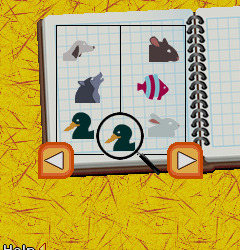
Top Tips For Understanding Java Shows.
While there are some jobs that require a level in computer science or a related field, programs is a skill you can educate on your own. Typically, your experience with Java and establishing software program is more vital than verifying that you have a degree in the field.
Produce http://sqworl.com/3o280z
Why is Java so hard?
Is Java still free? The current version of Java - Java SE 11 is available from Oracle under an open source license at http://jdk.java.net/11/. Java SE 8 remains free of charge for general purpose desktop and server use and is available under the Oracle Binary Code License (BCL) at https://www.oracle.com/javadownload.


It offers all the assistance called for to learn Java shows language for the newbie along with an innovative designer. Hence, Udemy is taken into consideration as best among other systems to discover the Java shows language. It likewise teaches you exactly how to set up an atmosphere for Java shows. It offers cost-free video clip lectures regarding just how to begin programming with Java.
The very first site is mostly for Java designers, but the trouble set can be solved in any type of language. The 2nd site is language independent since it does not ask you to code online, rather it only checks your solutions with arbitrary input information. The developers of Java were highly affected by existing shows languages like C and C++, with which Java shares a lot of syntactic resemblances. Regardless of the current launch of a major upgrade to the system, Java is losing appeal based on the most recent monthly evaluation of programming languages by Tiobe Software program.
How many days will it take to learn Java?
Bottom line -- beyond the most elementary, the math you need will come from the problem domain you're programming in. NONE of that needs to be a barrier to learning Java development. If you can learn Java, you can probably learn more math if you need it -- just don't try to do both at the same time.
youtube
Advantage I was able to read this write-up, a minimum of I understand I get on the right track, which code must I study initially for beginners. You can learn programs with self research study, a conventional four-year level, or with a coding bootcamp. The problem of programming depends upon the language you intend to learn and the kind of software application you're making. It's finest not to bite off even more than you can eat when you're starting your studies to become a computer developer.
0 notes
Text
Java Tester Jobs In London
Why Testers Usage Java For Selenium? Selenium Java Tutorial.
#toc background: #f9f9f9;border: 1px solid #aaa;display: table;margin-bottom: 1em;padding: 1em;width: 350px; .toctitle font-weight: 700;text-align: center;
Content
Qualified Software Program Examination Automation Engineer.
Automation Testing Resources.
Examination Automation With Selenium Webdriver.
Leading Tips For Discovering Java Programs.
Suggestion # 3: Chrome Devtools: Mimicing Network Issues
Licensed Software Program Test Automation Architect.
Should I learn Java or JavaScript?
Even with competition from new languages, the demand for Java developers remains strong. In fact, Java is among the most in-demand programming languages on the job market, depending on whose numbers you look at. Today, Java is the most popular choice for writing Android apps.
For opleiding tester , an examination component could be a a fixed string, which is utilized as input for a technique. The test would verify if the method behaves properly with this input.

youtube

However, in some cases a mix of White and black box testing is additionally used in this phase. Non-functional testing includes testing efficiency, compatibility as well as physical fitness of the system under test, its protection and effectiveness among other things. In practical testing the tester would certainly inspect the computations, any kind of web link on the web page, or the various other field which on given input, result could also be expected. Java Selenium Automation Training Bangalore are typically further divided right into practical and non-functional testing.
Automation Testing Resources.
View even more details on Certification+ program below. We may tape or monitor phone conversation for training, customer care and quality assurance functions, and also to identify or protect against crime. For further info please see our Privacy Notice. Get customized program suggestions, track topics and programs with pointers, and also extra. Court the inner code high quality of your test collection and also suggestions possible renovations.
testen opleiding With Selenium Webdriver.
At The Understanding Academy, we offer a series of Java training courses consisting of, Java Programming, JavaScript for Beginners, JavaScript Shows, Java SE7 Shows and Java SE8. Every one of these courses supply prospects with an intro to Java and also just how Java should be utilized, with the latter two programs focusing on particular variations of Java. These programs will certainly the enable prospects to understand Java as a computer system as well as guarantee that it is being made use of appropriately to optimise the effectiveness of their organisation.
youtube
The code which is tested is typically called the code under test. This is called the application under test if you are testing an application. A software application examination is a piece of software application, which implements an additional item of software application. If that code results in the anticipated state or implements the anticipated series of events, it verifies. I would love to have accreditation in sophisticated Efficiency test designer.
If you are searching for some well-known tutorials to begin coding in Java shows language, then Coursera is the excellent place to find out.
A lot of the courses are free, and also there is no requirement to sign up for them.
You can find out about many various topics such as data scientific research, shows languages, and several others.
It offers video classes for Java programming in numerous languages.
Nevertheless, you can choose the costs programs to get a certification after the completion of the tutorial.
Hello there to my QA family, I am functioning as a High quality analyst considering that last 3 years, i require development in my job. Please direct me which is the most effective certification program i ought to consider button as well as career growth viewpoint.
Software testing skills are essential for programmers that wish to end up being senior programmers, particularly in big tech companies. Software application testing gets a bad rap for being difficult, time-consuming, repetitive, and most importantly - boring. But actually, it is a tested means to ensure that your software program will work faultlessly and also meet launch schedules. This stage is carried out in 2 modes, as a complete bundle or as an increment to the earlier bundle. The majority of the time black box testing technique is made use of.
We have 100% certain pass research study overview on ISTQB structure degree exam. It includes 800+ technique inquiries, 200+ costs inquiries, and numerous books based on ISTQB exam syllabus. If you are interested in getting this study guide pleasecheck this page. For all of the Java courses we supply, it is needed that individuals have prior knowledge of Java, HTML, and also the details program that they are signing up on.
Top Tips For Understanding Java Programs.
You will not get a "certification" however it's the most effective hands on testing training you can get anywhere. Yes, as far as eligibility is concerned, one need not have to wait till 11 years to do CSM/ PMP.
If you outfit yourself with this qualification, you will have the ability to contribute greatly in the direction of building automation solutions for company as well as developing test automation design. In addition to these above accreditations in Agile testing, you can additionally opt for professional scrum developer accreditation used by Scrum. Test leads & examination managers that deal with handling the test initiatives in Active tasks. After obtaining this accreditation, they will certainly have the ability to manage the test initiatives more effectively.
Can I learn Java without any programming experience?
Coming to Java - or any object-oriented language - from C can be tough. Fortunately for OP, Python and Java both support OOP (as do nearly all widely-used industry languages). To the point, I agree that Java is very easy to learn from a Python background. Python and Java share a ton of core programming concepts.
In white-box testing the tester cares with the implementation of the statements via the message data. To make certain completeness of testing, the tester usually follows a written examination strategy that leads them through a group of essential examination cases. Right here are some web links to help you get one of the most out of your accreditation. To achieve this certification+ the base qualification cert.baseCert.description should be attained.
However as I have actually pointed out in my article-- the qualification must map your experience- and also this is based on my experience. When you enroll for the accreditation, the research study product is sent to you. The examination includes 50 concerns to be finished in 1 hr with 50% passing percent.
Can I learn Java in a week?
If you have prior knowledge of C language and the concepts, learning Java becomes easier. Java can be downloaded easily and anyone can download the JRE and run the Java program. There are many tutorials available on the tutorialspoint website where you can learn Java from scratch even without much coding background.
0 notes
Text
How to Build a Niche Website (Step-by-Step Case Study)

Ever dreamed of lying on the beach while earning tons of passive income?
I did.
I wanted to build my own business that generated thousands of dollars while I slept, partied, and traveled around the world.
So, in 2015, my friends and I created a niche website to teach beginners how to breakdance.
Sadly, we never made enough money to quit our jobs and move to paradise.
But here’s the thing…
Though we weren’t successful, the experience taught me a lot about how to build a niche website, market it, and monetize it. And combined with the knowledge I’ve gained working at Ahrefs, I now know the keys to success.
In this post, I’m going to show you what I’ve learned:
What I did right, what I did wrong, and what I would do differently if I created a new niche site today.
Back to Top
We’ll start with a quick definition, followed by a few examples…
What is a Niche Website?
A niche website is a website that caters to a small segment of a large market by focusing on a common, specific interest.
My website, BreakDance Decoded, was a niche website. It specifically targeted breakdancers, which is a small part of the much larger “dance” market.
Other examples of niche sites are Mr. Money Mustache (focusing on saving and budgeting in the personal finance market) and Kopywriting Kourse (focusing on copywriting in the marketing/business market).
There’s a common misconception that a niche website is a small site. This isn’t true.
“Niche” refers to the segment of the market, not the size of the website.
A site can be niche and still have thousands of pages covering a variety of topics related to the niche.
Case in Point
Nerd Fitness is a niche website that writes about fitness for nerds. Even though it’s only targeting a specific type of persona, the site has hundreds of blog posts ranking for important keywords in Google.
In general, a niche website is an information website. It either produces or sells information that solve problems (e.g. courses, ebooks, etc.).
It may eventually pivot to other monetization models like e-commerce, but the core engine behind the site is information.
Now that you know what a niche site is, let’s take a look at how you create one:
Back to Top
How to Create a Niche Website in 2019 (Step-By-Step)
Choose Your Niche
Setup Your Site
Do Topic Research
Create Your Content
Promote Your Content
Grow Your Email List
Experiment With Monetization
1. Choose Your Niche
For many aspiring bloggers, niche selection is one of the most challenging dilemmas they face when starting a blog.
They either have too many ideas, or — worse — they have no idea what kind of site they should build.
It doesn’t help that there’s lots of contradictory advice out there: some people suggest you start with your passion, while others say you should choose a niche that’s profitable.
How I Chose My Niche
Personally, I started with my passion.

Not counting my job, breakdancing was the activity I spent the most time doing. So, setting up a niche site that would educate people about breakdancing was a no-brainer for me.
If you’re completely new to building a site and you just want to learn how things work, I would recommend you start with your passion.
Why?
Because growing a website is hard work.
But if you’re creating content on a topic you’re passionate about, you’ll be able to find the motivation to persist on those days you feel like quitting.
(And trust me, those days will be frequent.)
How I Would Choose My Niche Today
Today, I would choose a profitable niche.
What’s that?
It’s a niche with a large audience that buys things.
And that’s what you want:
A market where people are buying, buying, and buying.
While it was fun to write about breakdancing, it was a tough market to crack. When we started, there weren’t any other niche sites about breakdancing. Our competing sites were mostly e-commerce stores selling apparel for breakdancers.
In hindsight, that should have been a warning sign.
If there are no competitors in the SERPs (Search Engine Results Pages), you should be concerned.
Competitors = Viable Market
Competition is healthy. It’s a sign the market is worth entering. It’s a sign there’s money to be made.
We should have listened.
To help you avoid the mistake we made, here are a couple tips to help you find profitable niches:
Tip #1: Brainstorm + Snooping Around
Sit down and brainstorm some niches you’re interested in pursuing. Then, do a quick Google search to see if there are any sites dedicated to them.
You can search for “best [niche] blogs” to get started (e.g. “best breakdancing blogs”).
And once you’ve found a few potential competitors in your niche, “snoop” around their site and see how they’re monetizing.
If they have a variety of products, it could be a good niche.
For example, let’s say I am interested in the paleo niche. A quick Google search for the “best paleo blogs” brings me to this site:

Looking around, I can see Diane monetizes her site in a variety of ways:
Books
Programs/Courses
Amazon Affiliates
Certifying other health coaches
Etc.
Seems like a good niche!
Tip #2: Browse Affiliate Marketplaces
Alternatively, you can also look into affiliate networks like ClickBank and Amazon Associates. These are middlemen networks that connect bloggers and niche site owners with companies offering affiliate marketing opportunities.
You have an audience, they have a product. Perfect match!
Affiliate networks are ideal because:
These products are being bought by people interested in different niches;
They have a variety of categories you can browse.
Just go through them until you find products you’re interested in.
Here’s an example:
Right now, I’m learning Russian. So, I might be interested in starting a niche site about the Russian language.
And lo and behold, ClickBank has a category for the Russian language. Cool!
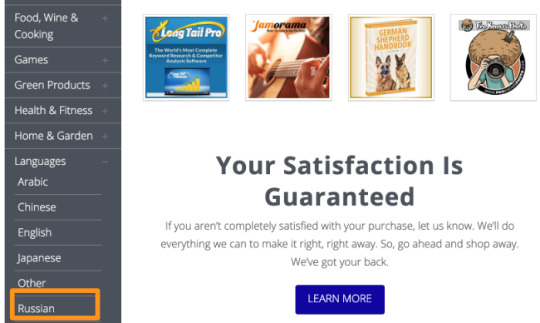
Unfortunately, there is only one product for sale in this category.
That isn’t promising. If it was a profitable niche, there would probably be more options.
However, when I click on “Languages”, I see lots of courses. And if I follow tip #1, searching for “best language hacking blogs” brings back a strong list of competitors, such as Fluent in 3 Months.
So, “Russian” might be too niche.
But “language” learning could be a niche worth pursuing.
Key Takeaways
If you’re completely new, start a niche website for one of your hobbies or passions.
If you know what you’re doing, choose a profitable niche.
To find profitable niches, do a Google search to see if there are any sites ranking in the SERPs for your target topic. If there are, snoop around to see if they’re monetizing.
You can also use affiliate networks like ClickBank to find interesting niches to enter.
Further Reading
How To Find A Niche That Is Guaranteed To Be Profitable by Authority Hacker
Find Your Niche With My Secret To Finding Profitable Niche by Matthew Woodward
How To Find A Profitable Niche For Your Blog (7 Simple Steps) by Cloud Living
Back to Top
2. Setup Your Site
Done with niche selection?
Great. Now it’s time to setup your site.
There are four things you need when you first get started:
Domain
Hosting Provider
Content Management System (CMS)
Theme (Plus Some Essential Plugins)
Now, don’t worry if you’re not tech-savvy. I wasn’t great when I started too. I’ll be running through what each of them are, so you can get started fast.
How I Setup My Site (and How I Would Do it Differently Today)
See this?

This is a domain. Think of your domain as the address to your house.
A lot of beginners get stuck on this phase. They procrastinate, hoping to find a perfect domain name.
The hard truth? There’s no such thing.
For us, we wanted a domain that was memorable but self-explanatory. We wanted people to understand what the site was about immediately.
That meant we needed the word “breakdance” in our domain. After brainstorming a few ideas, and consulting the thesaurus, we settled on breakdancedecoded.com.
Don’t spend all your time deciding on the domain. Just make sure it is:
Short and memorable;
Easy to spell. Imagine if someone asked you for your domain in real-life. Would it be easy for someone to remember and type it in later, or would they struggle to remember?
Includes your niche. This tells the visitor right away what your site is about.
If you’re stuck, you can use a tool like Domain Name Brain to give you some ideas:
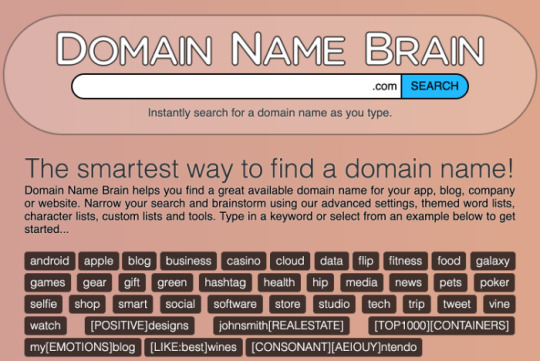
Once you’re done deciding the name, check if it is available in a domain registrar like NameCheap (affiliate link) or Hover.
Next: A Hosting Provider
To have a house, you need to have the architecture to hold it.
Your host is that architecture.
A hosting provider allows your website to be accessible on the Internet.
Since we weren’t technically-savvy, we followed a friend’s instruction and got our hosting from WPEngine.
In hindsight, that wasn’t a good decision. WPEngine is great, but it is pretty costly for a beginner site that won’t get that much traffic.
If you’re starting out, you probably won’t be getting very much traffic. So, it’s better to get a cheaper host.
There are plenty of hosting providers out there. Take a look around. Smart Blogger recommends SiteGround (affiliate link), so they’re one option to consider.
Editor’s Note:
I would be remiss if I didn’t mention Jon’s in-depth guide on web hosting.
Before you choose a hosting provider, be sure to check out WordPress Hosting: A Brutally Honest Guide That’ll Save You Money.
Content Management System (CMS)
A content management system is an online tool that enables you to create and manage your content (e.g. blog posts). WordPress is the most popular CMS, but there are other alternatives too.
Since we were using WPEngine, we turned to WordPress as our blogging platform.
As you’ll see later on, the biggest traffic channel for a niche site will likely be Google. As such, you should choose a CMS that is SEO-friendly.
Most search engine optimization (SEO) experts recommend WordPress, and it’s the CMS I recommend too.
Editor’s Note:
The steps for installing WordPress will depend on your hosting provide and your particular situation.
But don’t worry.
Chances are excellent our massive, step-by-guide on How to Install WordPress in 5 Minutes or Less will be able to walk you through the tricky parts.
Once you’re done with the installation, you’ll need a theme.
A theme is a template that defines the appearance of your site. (Think of it like the design of your house).
For our theme, we chose Genesis.
Genesis isn’t the best-looking theme around, but at the time we were looking for efficiency and ease of use. (Plus, we weren’t that great with design.) We also figured that we could upgrade to a better theme later on, if we got more successful.
Genesis Theme in Action
With its simplicity, Genesis was a great theme for us. If you’re more design-savvy, feel free to pick another theme.
Smart Blogger recommends Elegant Themes (affiliate link), but you can also browse through the selections in ThemeForest.
Once you’re done, install these two free plugins:
Akismet. Helps you combat comment spam.
Yoast SEO. Helps you easily optimize your on-page SEO.
If you want more WordPress plugins to install, check out this list of time savers.
Key Takeaways
Don’t get analysis paralysis when it comes to your domain name. Choose one that is memorable, easy to spell, and includes your niche.
Since you won’t get very much traffic initially, start with a cheaper, flexible host, like SiteGround.
Choose WordPress as your CMS.
Further Reading
WordPress SEO: The Only Guide You Need by Viper Chill
WordPress SEO: A Practical (and EASY) Guide by Ahrefs
Back to Top
3. Do Topic Research
Your foundation is set.
It’s time to start getting traffic to your site.
How I Did My Topic Research
Now, at this point, most bloggers make the same mistake:
They write about whatever tickles their fancy.
I know because I did the same thing.
I brainstormed topics I thought would resonate with my audience, and then I wrote about them. The only reason I got away with it was because I was a breakdancer writing to other breakdancers.
I knew the topics that would interest my audience because I was a part of that audience.
But if you’re working in a niche that is unfamiliar to you, you can’t just write about anything you want.
Those topics won’t resonate and you won’t build an audience.
Worse:
Your content won’t rank in Google, which means no traffic will come to your site.
How I Would Do My Topic Research Today
For most niche sites, the best way to get traffic is SEO.
SEO is an acquisition channel that will grow passively. As long as you are ranking well for the keywords you’re targeting, you will get passive traffic.
Compare that with other channels.
You could experiment with paid ads (for example, Facebook ads), but as soon as you stop the campaign or run out of money, your traffic dries up immediately.
The same goes for social media. You have to either build up a large audience (difficult) or bank on viral hits (also difficult). And as soon as you stop tweeting and sharing, whatever traffic you were getting will disappear.
Search engine traffic doesn’t stop. It keeps going. Even when you’re sleeping.
If you want search traffic, you need to write about topics that people are searching for. In other words:
You need to create content for topics with search traffic potential.
In SEO parlance, this is known as keyword research.
Here are a few ways you can do it:
Use a Keyword Research Tool
The easiest way to get started is to use a keyword research tool.
Enter any seed keywords related to your niche into a keyword research tool, and it will generate hundreds of different ideas you can target.
For example, here’s a free keyword tool called AnswerThePublic:

AnswerThePublic generates ideas for you based on different categories: questions, prepositions, comparisons, alphabeticals, etc.
There are plenty of other free tools out there, like:
Google Keyword Planner
Wordtracker Scout
Keywords Everywhere
Take your pick.
One of the most important metrics SEOs look at when doing keyword research is search volume. Essentially, search volume is the amount of searches per month for a keyword.
The problem with a free tool is that, while it’s free, it usually has either missing or incomplete data.
As such, you might want to consider using a professional keyword tool like Ahrefs’ Keywords Explorer (affiliate link).
You can access it using the Ahrefs’ $7 for 7-days trial.
Enter a seed keyword into Keywords Explorer, and it will generate thousands of keyword ideas, plus all sorts of relevant SEO metrics:
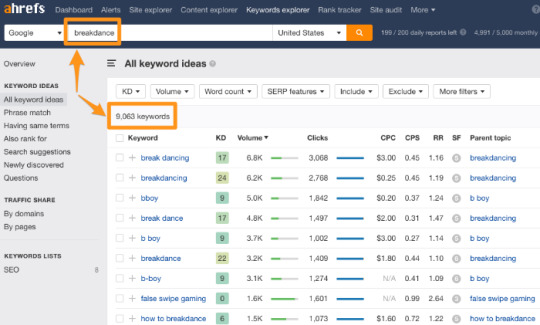
Here’s a quick explanation of everything you’re seeing in the above screenshot:
Keyword Difficulty (KD). Ahrefs’ Keyword Difficulty metric gives you an estimate of how hard it would be to rank in the Top 10 search results for a given keyword.
Search volume (volume). This shows you how many times per month, on average, people in a given country search for your target keyword.
Clicks. This shows you the average monthly number of clicks on the search results that people make while searching for the target keyword.
Cost-per-click (CPC). This shows you the average price that advertisers pay for a click on their ad in Google’s paid search results for a target keyword in a given country.
Clicks-per-search (CPS). This shows you the average number of clicks people perform after searching for a given keyword.
Return Rate (RR). This shows you how often the same person searches for a given keyword over a 30-day period.
SERP Features (SF). This refers to how many Google’s SERP Features appear in the search results for this keyword.
Parent Topic. This shows you a better topic you can target as opposed to the keyword you’re entered.
Lurk in Communities
There are communities for every imaginable topic out there.
Love the TV show Brooklyn Nine-Nine? There’s a subreddit for that. Enjoy discovering new products? Well, that’s how ProductHunt was formed.
You name it, they have it.
People gather in these communities to ask questions, discuss trending news, get recommendations, and so on.
Translation: these communities offer a wealth of topics for your niche site.
When we started, we hung out a lot on r/bboy, a subreddit for breakdancers. This was where we got our initial list of topics:

You can do the same too.
Do a search and find all the communities related to your niche. You can find them in places like:
Reddit;
Quora;
Facebook;
Slack;
Forums (yes, they still exist);
And much more.
To find out if these topics have search traffic potential, you can install the Chrome/Firefox extension Keywords Everywhere on your browser.

You can also enter these topics into Keywords Explorer.
Ahrefs will show you all the SEO metrics, plus suggest a better topic for you to target (“Parent Topic”).

Figure Out What Your Competitors are Ranking for
Your competitors have done the hard work for you. They’ve been blogging and ranking in Google.
Your job? Borrow generously.
Find out what’s working for them, and then replicate those topic ideas.
Most sites feature their best-performing posts on their blogs, usually in a sidebar:
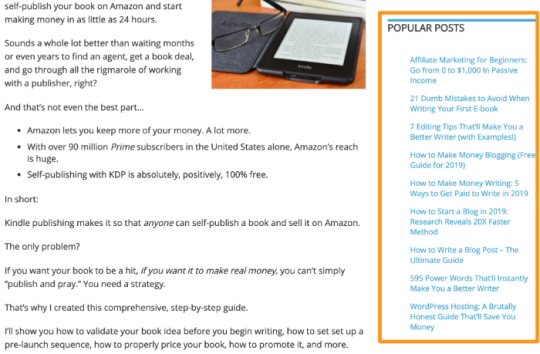
You can easily see which keywords they’re optimizing for.
For example, the post 595 Power Words That’ll Instantly Make You a Better Writer is obviously optimizing for the keyword “power words.”
If you’re unsure, you can click through to the post. If they’re SEO-savvy, they would have optimized their URLs for the target keyword.

Of course, the best way is to use a tool like Site Explorer.
Enter your competitor’s domain into the tool and go to the “Top Pages” report, where you’ll see all the pages sending them the most search traffic:
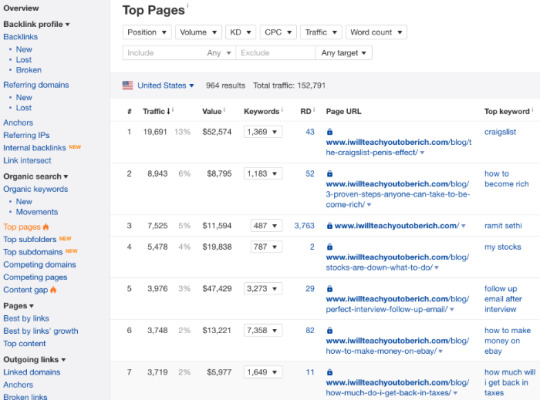
Key Takeaways
To get search traffic to your niche website, you need to target topics that people are searching for. To do this, you need to do keyword research.
You can either use a free keyword tool or a paid, professional version.
The paid version will also allow you to check all the keywords your competitor sites are ranking for.
To find out what your readers are searching for, you can also lurk in communities to find widely-discussed topics.
Further Reading
What to Blog About: 3 Steps to Mapping out Your Ideas in a Logical Way by Jon Morrow
Keyword Research: The Definitive Guide by Backlinko
How to Do Keyword Research for SEO by Ahrefs
Back to Top
4. Create Your Content
Jon Morrow is right:
“The best content is king.”
If you want to rank in Google, build an audience and compete with others, you have to create epic content.
You have to publish the best article ever written about those topics with search traffic potential.
The posts have to be detailed.
They have to be in-depth.
They have to answer every single question about that topic.
How I Created My Content
When we began our niche site, we were already huge fans of the detailed, long-form articles published by Smart Blogger and Backlinko.
So, we sought to emulate them.
We even published a 17,000-word article on how to get started with breakdancing.
It was our most successful article, but it took us almost a month to write.
You might be wondering:
“If you’re writing such long articles, how can you publish something every day?”
Answer: you don’t.
Publishing every day is a fool’s game.
What you should do is to focus on quality, not quantity.
If you have to publish less, so be it. Don’t sacrifice the depth of your article on some arbitrary content schedule.
(For us, it was impossible to stick to a schedule, as we had full-time jobs.)
You want to be known for the quality of your work — not how quickly you pump out new articles.
That being said, what does it mean to create great content?
When we started, all we knew was we needed to create something in-depth. We weren’t writers and had no blogging experience.
In short, we had no way to measure and define “great content.” We just went with our instincts.
Today, things are different. After reading and writing so many pieces of content, I can see which articles can be classified as great, and which can’t.
How I Would Create My Content Today
I no longer need to rely on my instincts. I know what “great content” is and what it must embody. It needs the following three characteristics:
Characteristic #1: Quality
Quality is subjective, of course.
How then do you know you’ve created something worth shouting about?
In my experience, quality consists of three factors:
Design. Is the website design great? Is it easy-to-read? Are the images beautiful? Or is the site cluttered with hundreds of banner ads, each distracting your reader from the main purpose, which is to consume the content?
Content. Does the article flow? Is it interesting, entertaining, and useful? Or is the article full of grammatical and spelling errors that makes reading it off-putting?
Usefulness. Does the article actually solve a problem? Does it discuss the topic in-depth? Or is it merely beating around the bush?
If the content you produce meets these three factors, it’s great content.
Characteristic #2: Uniqueness
There are thousands, if not millions, of articles published on similar topics each and every day.
Why would someone choose your article over the others?
The best way I’ve found to create unique content is to write from personal experience.
Pro Tip: This is how Smart Blogger became such a powerhouse in the blogging world. When Jon writes about blogging, it comes from his years of experience. When a guest author is invited to write about a topic, they’re chosen because they have had experience in those areas.
Characteristic #3: Authority
Do you want to learn astrophysics from a Caltech physicist, or your next-door neighbor?
Of course, it’s the Caltech physicist. (Unless, you once lived next to Richard Feynman.)
Your readers are the same way.
No matter the topic, they want to learn from an authoritative source.
If you’re the expert, great! Carry on.
But what if you aren’t?
Get the experts to help you. Be the journalist. The scribe. There are plenty of experts with great knowledge, but insufficient ability to communicate that knowledge.
You can be the go-between.
Interview them. Curate their thoughts, research and expertise. You can even invite the expert to write an article for you.
For example:
Tim Ferriss. Tim doesn’t have expertise in every topic in the world, but he touches lots of topics. He does this by inviting experts to contribute to his books.
Pro Tip: This is also the reason why Smart Blogger succeeded when many failed. If Jon doesn’t have experience in something (e.g. Kindle Publishing), he doesn’t write the article. Instead, he invites someone with experience to do it.
If you read our epic guide to breakdancing, you’d see it checked all three aspects we just covered:
Quality. While it wasn’t the best-designed post, we formatted it well and added a header image (done on Canva). We even added a Table of Contents!
Uniqueness. We wrote the entire thing based on our years of experience in dance. We told plenty of stories that were highly unique to what we had seen and observed.
Authority. All of us had at least 7-8 years of breakdance experience.
Key Takeaways
If you want to rank in Google, make sure you create great content.
Focus on quality — not quantity or satisfying some “content calendar.”
Great content has three characteristics: quality, authoritativeness, and uniqueness. You need to do all three.
Further Reading
How to Write a Blog Post in 2019: The Ultimate Guide by Liz Careathers
Demystifying Epic Content: How to Actually Create It (Not Just Jabber About How Important It Is) by Sonia Thompson
How to Write a Blog Post in 9 Steps (That People Actually Want to Read) by Ahrefs
Back to Top
5. Promote Your Content
Do you want to know the greatest lie in the content marketing world?
It’s this adage:
“If you build it, they will come.”
Nothing can be further from the truth.
Think about it.
According to the latest stats, there are 4 million blog posts published every single day. That’s a lot of noise.
That also means there is an extremely low chance that somebody will randomly stumble upon your site.
If you want traffic, you have to be proactive. You have to promote your content. You have to build links.
How I Promoted My Content
We focused on three promotion techniques:
Technique #1: The “Eager Sneezers” Technique
In a post published in 2015, Bryan Harris shared how he started an email list from scratch and got 205 subscribers in 48 hours.
The technique he used? “Eager Sneezers.”
Ignoring the fancy name, it’s essentially reaching out to your friends and inviting them to join your email list.
Bryan’s biggest takeaway was your friends want to help you (so let them).
We used a variation of this idea to get our early traction.
After publishing a post on breakdance music, we reached out to multiple friends to help share it.
Fortunately, as we were breakdancers ourselves, we had a number of breakdancer friends who were more than happy to help:

Technique #2: Community Content Promotion
Remember the communities you joined earlier (where you were “lurking” for ideas)?
They’re great for content promotion too.
Here’s one example of what we did:

Now, this is not an excuse for you to strut into someone else’s community and start spamming links to your content.
Online communities exist for people to have meaningful conversations about a particular topic. Link spam defeats that purpose.
Plus, you’ll likely get booted out of the group.
The only reason I was able to promote my content in a group like this was because I was already an active member. I was participating in discussions, asking questions, and commenting.
I knew what kind of content the community would appreciate, which was why I was able to share it.
So, before you start dropping links to your content in a group, make sure you are active and understand the group’s rules.
Technique #3: Outreach to People You’ve Mentioned in Your Content
If you’ve written an epic piece of content, you’ve likely linked out to sources or quoted experts.
Let them know!
For example:
In our post, we listed 157 songs a breakdancer must listen to. This meant 157 different people we could email.
So, we did. And it resulted in one of the featured artists sharing our post on Facebook:
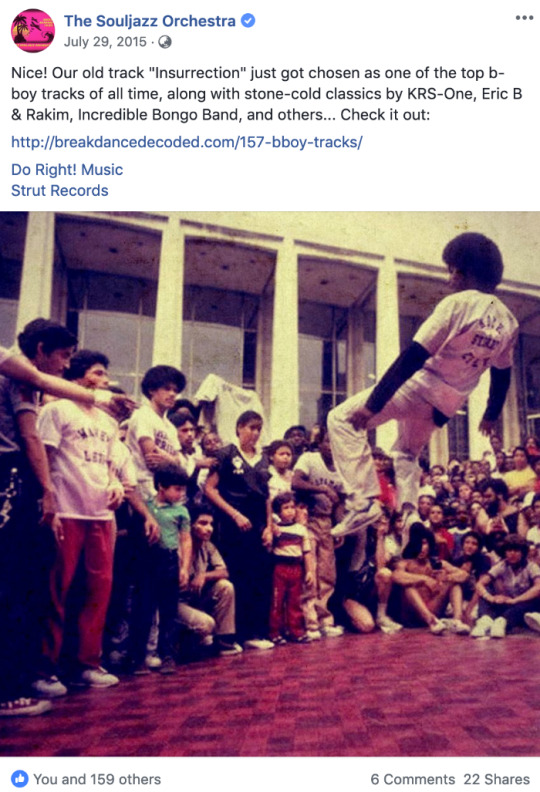
How I Would Promote My Content Today
According to a survey of 1,117 bloggers, higher-income bloggers put more emphasis on promoting their content than lower-income bloggers.
Translation: if you want to succeed, you have to keep on promoting your content.
If I were to create a new niche website, I would add these content promotion strategies into my toolkit.
Strategy #1: Outreach to People Who Published Articles on the Same Topic
Since they’ve written on that topic before, there is a higher probability they’ll be interested in seeing your post.
To find these people, simply enter the topic of your article (remember to try variations!) into Google. Collect the list of articles that appear in the SERPs.
Then find their email address and reach out.
Alternatively, you can use a tool like Ahrefs’ Content Explorer, a search engine for web content.
Enter the topic into Content Explorer, do some filtering (like “English only”), and export the list.

You now have a huge list of sites to reach out to.
All that’s left is to write the email.
Here are a few tips to help you write a compelling email:
Keep it short. Most people are busy. You improve your chances of getting your emails read if it’s short and to the point.
Tell them what’s in it for them. Everyone looks out for #1. Provide value upfront and let them know what they can get out of it.
Personalize the email as much as possible. People can tell when an email is a template. If they think it’s a template, they’ll delete it without reading.
Ask wisely. People dislike being told to do something. Don’t be pushy. If you’re asking for a link, suggest the idea gently.
You can also read this in-depth guide about blogger outreach.
Strategy #2: Guest Blogging
Guest blogging is a tactic where you write a post for another website (instead of yours).
In exchange for your “free” article, the owner gives you:
A few links back to your site (either within the body content or inside the author’s bio);
Exposure to their audience;
Referral traffic.
Those are just the immediate benefits. Guest blogging also allows you to build relationships with influencers, or even grow your email list.
The biggest challenge with guest blogging is finding blogs willing to accept your guest posts.
To increase your chances of being accepted, look for sites that are already accepting guest posts.
You can find these sites via Google search operators. Here are a few examples:
[your_topic] “write for us”
[your_topic] “become an author”
[your_topic] “guest post”
[your_topic] “guest article”
[your_topic] inurl:contribute
These sites usually have a “write for us” page, so all you have to do is to follow their instructions.
You can also look for these opportunities in Content Explorer. The reasoning: if a blog has written about a topic before, there is an increased probability they would cover it again.
Enter any word/phrase from your niche into Content Explorer.
Check the “one article per domain” box to get a list of unique domains you can potentially write for:

Some of these sites may not have an obvious “write for us” page. But, most blogs will accept a guest post if your pitch is good enough.
Key Takeaways
If you want traffic, you have to promote your content.
To kick-start your site and get some initial traction, try the “Eager Sneezers” technique.
You can also promote your content in communities.
If you’ve mentioned anyone in your posts, reach out and let them know.
To take it to the next level, try guest blogging and reaching out to people who’ve written about similar topics.
Back to Top
6. Grow Your Email List
Study the best sites in any niche, and you’ll notice one thing:
They all build an email list.
An email list is powerful because you can do almost anything with it. You could:
Survey your subscribers to get content ideas;
Ask them for feedback;
Test monetization ideas;
Sell something.
The possibilities are virtually endless.
How I Built My Email List
Because we were observing these huge sites, we understood the power of the email list very early on. In fact, we obsessed over collecting as many emails as possible.
We tested all kinds of strategies on the site.
Welcome Mats:
Content Upgrades:

We even turned our homepage into an email collection machine:

How I Would Build My Email List Today
In hindsight, we were too aggressive with our email collection.
We were so concerned with the number of emails on our list, the quality of our list suffered.
We should have focused on user experience and only placed email sign-up forms where relevant.
Over the years, Jon and the rest of the Smart Blogger team have written tons of guides on email list building, so I won’t delve too deeply into this topic.
You can check out the different resources here:
The Ultimate List-Builder’s Resource Guide: 109 Links to Double or Even Triple Your Subscribers
9 Irresistible Incentives That’ll Grow Your Email List Like Crazy
10 Creative Places for Opt-In Forms That’ll Supercharge Your Signups
9 Plugins for Growing Your Email List That Work So Well It Feels Like Cheating
The Quick and Dirty Guide to Creating Your “Bribe to Subscribe” in Record Time
Key Takeaways
Build a list! It’s the most important thing you need to do.
Test different methods for collecting emails on your site.
But don’t neglect user experience. Don’t cram 100 pop-ups on your site just so you can get a few more subscribers.
Back to Top
7. Experiment with Monetization
What’s the purpose of a niche site?
To make money!
As you start gaining traction on your site, and gaining a few subscribers, you can start to look into monetization.
How I Monetized My Site
At BreakDance Decoded, we experimented with a few different strategies.
Strategy #1: Patreon
Patreon is a membership platform where fans can “fund” content creators. You can create separate tiers on Patreon to reward different levels of loyalty.
Back then, Patreon was a relatively new-ish platform. We saw that a few legitimate artists and creators were generating significant amounts of money on the platform, so we gave it a shot.
This was our Patreon page:

No matter how hard we marketed ourselves, the best we did was $50 per month on Patreon.
That’s not to say Patreon doesn’t work.
There are plenty of successful Patreon artists, like Kurzgesagt, who has over 12,000 patrons supporting his work:

Your results may vary.
Strategy #2: YouTube AdSense
In addition to our website, we were also running a YouTube channel. So, we decided to see if we could make enough money from YouTube.
Yes, we dreamed of being the next PewDiePie.
These were our results:

It was decent, but it wasn’t enough for a “passive income” source.
Plus, our niche was too “specific”, so we probably didn’t generate enough views to make financial sense.
Strategy #3: Coaching
One of Jon’s recommendations was to sell video or phone coaching as a quick way to monetize your site.
We took it seriously.
We sent an email to our list, telling them we were available for personal breakdance coaching. At the time, this was a relatively new concept to the niche, so we weren’t sure if it would work out.
Surprisingly, someone took us up on it.
Strategy #4: Online Courses
By 2025, the e-learning industry will grow to about $325 billion in size.
This probably explains why most popular blogs monetize via online courses.
However, our biggest concern (back then) with an online course was the time and effort it took to create a great one. Plus, we weren’t sure if there were any demand for an online breakdance course.
The notion of spending considerable time, effort, and money into creating a course no one wanted didn’t sound appealing.
But after testing all the different strategies listed earlier, creating an online course seemed to be the most viable option.
So, we decided to launch a MVP (Minimum Viable Product).
We sent a survey to our email list, asking them for their #1 challenge.
From there, we came up with a hook we thought would interest our audience:
Hey friend,
Don’t you feel like breaking has limited support and not enough is done to help you improve?
Sure, there are tons of studios out there, and jams have become widespread.
But not every breaking tutorial fixes the problem effectively. Not everyone gets access to the information and knowledge from other bboys. Not every country or state has a strong breaking scene.
This lack of environment for growth sucks, because so many potential bboys and bgirls around the world deserve a chance to learn breaking.
Ideally, a bboy/bgirl’s progress should only be ‘limited’ by their own effort. Not the environment.
As a first step to tackle this problem, I’ve created a 1-minute survey to get to know you better (don’t worry it’s 5 simple questions, no right or wrong answers here.)
So click this link to fill up our quick survey!
Thanks for helping me to understand your breaking views. It will go a long way for both you and me 🙂
While we waited for feedback, we created an outline for a potential 9-week course.
Using the email hook and the outline, we crafted a 5-day email sequence modeled after Ramit Sethi’s successful launches.
Not knowing what to charge, we decided on an arbitrary sales price of $37. For the test to be successful, we told ourselves that we needed at least 10 sales.
As we weren’t technically savvy, we had no idea how to collect orders online. We also didn’t have money to invest in a shopping cart software.
So, we kept it simple:
We created a PayPal link.
Then we activated the 5-day campaign by sending our subscribers a launch email.
To our surprise, we actually managed to sign up 12 students.
Our test was successful!
The only issue? We now had to actually create the course.
Once again, instead of investing in some complicated course software to launch it, we decided to do it the easy way:
Facebook had just launched its “Live” feature and was heavily promoting it.
We decided to use it.
We created a closed Facebook group, sent an email to our 12 students, and invited them to join the group:
Our Closed Facebook Group
Then we filmed each lesson by using Facebook’s Live feature.
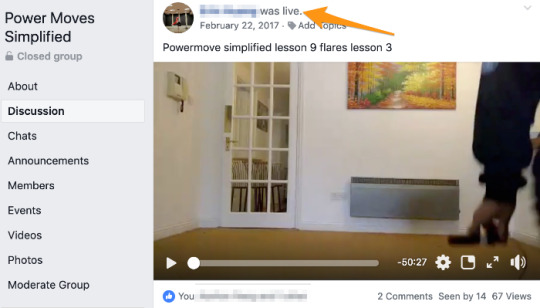
Besides some technical issues (like audio), we received rave reviews for our course.
Takeaway:
Don’t let perfectionism stop you from launching. People buy courses for the information, not the software you use or how perfect it looks.
What I Would Do Differently Today
I wouldn’t change a thing.
Online courses worked for me then, and it’s the monetization strategy I would use today.
That said…
Your results may vary.
It’s a good idea to play around with different monetization methods to see what works best for you. Even if you find a cash cow, always be looking at different ways you can diversify your income stream.
Otherwise, you’re asking for trouble.
Nomadic Matt has a blog that receives 1 million visitors each month, but as shared in his interview on Noah Kagan Presents, if he had continued with the same business model he had when he started (i.e. selling links), his business would have been dead in the water by now.
Key Takeaways
Test different monetization strategies and see which one works out best for you.
Patreon, online coaching, and online courses are all viable methods to generate revenue.
You can also consider other methods like affiliate marketing, selling eBooks, and so on.
Further Reading
How to Make Money Blogging (Free Guide for 2019) by Jon Morrow
Affiliate Marketing for Beginners: Go from 0 to $1,000 In Passive Income by Leanne Regalla
How to Make Money Writing: 5 Ways to Get Paid to Write in 2019 by Glen Long
Back to Top
Are You Ready to Create a Profitable Niche Website?
This wasn’t a case study about how successful I am or how many Lamborghinis I now own.
It’s the opposite.
My site wasn’t successful by any means.
Instead of sipping mojitos at the beach, I’m still working out of an office.
But that’s because I didn’t know then what I know now.
Now I know better. Now I know what to do. And now so do you.
It is possible to build a niche website and monetize it.
So what are you waiting for?
Paradise is waiting.
About the Author: Si Quan Ong works in marketing and customer success for Ahrefs, the SEO toolset that helps you grow your search traffic, research your competitors and dominate your niche. If not evident by now, he also breakdances on the side, and has a dream to visit 100 countries. Follow him on Twitter to learn more about his misadventures.
The post How to Build a Niche Website (Step-by-Step Case Study) appeared first on Smart Blogger.
from SEO and SM Tips https://smartblogger.com/niche-website/
0 notes
Text
How to Build a Niche Website (Step-by-Step Case Study)

Ever dreamed of lying on the beach while earning tons of passive income?
I did.
I wanted to build my own business that generated thousands of dollars while I slept, partied, and traveled around the world.
So, in 2015, my friends and I created a niche website to teach beginners how to breakdance.
Sadly, we never made enough money to quit our jobs and move to paradise.
But here’s the thing…
Though we weren’t successful, the experience taught me a lot about how to build a niche website, market it, and monetize it. And combined with the knowledge I’ve gained working at Ahrefs, I now know the keys to success.
In this post, I’m going to show you what I’ve learned:
What I did right, what I did wrong, and what I would do differently if I created a new niche site today.
Back to Top
We’ll start with a quick definition, followed by a few examples…
What is a Niche Website?
A niche website is a website that caters to a small segment of a large market by focusing on a common, specific interest.
My website, BreakDance Decoded, was a niche website. It specifically targeted breakdancers, which is a small part of the much larger “dance” market.
Other examples of niche sites are Mr. Money Mustache (focusing on saving and budgeting in the personal finance market) and Kopywriting Kourse (focusing on copywriting in the marketing/business market).
There’s a common misconception that a niche website is a small site. This isn’t true.
“Niche” refers to the segment of the market, not the size of the website.
A site can be niche and still have thousands of pages covering a variety of topics related to the niche.
Case in Point
Nerd Fitness is a niche website that writes about fitness for nerds. Even though it’s only targeting a specific type of persona, the site has hundreds of blog posts ranking for important keywords in Google.
In general, a niche website is an information website. It either produces or sells information that solve problems (e.g. courses, ebooks, etc.).
It may eventually pivot to other monetization models like e-commerce, but the core engine behind the site is information.
Now that you know what a niche site is, let’s take a look at how you create one:
Back to Top
How to Create a Niche Website in 2019 (Step-By-Step)
Choose Your Niche
Setup Your Site
Do Topic Research
Create Your Content
Promote Your Content
Grow Your Email List
Experiment With Monetization
1. Choose Your Niche
For many aspiring bloggers, niche selection is one of the most challenging dilemmas they face when starting a blog.
They either have too many ideas, or — worse — they have no idea what kind of site they should build.
It doesn’t help that there’s lots of contradictory advice out there: some people suggest you start with your passion, while others say you should choose a niche that’s profitable.
How I Chose My Niche
Personally, I started with my passion.

Not counting my job, breakdancing was the activity I spent the most time doing. So, setting up a niche site that would educate people about breakdancing was a no-brainer for me.
If you’re completely new to building a site and you just want to learn how things work, I would recommend you start with your passion.
Why?
Because growing a website is hard work.
But if you’re creating content on a topic you’re passionate about, you’ll be able to find the motivation to persist on those days you feel like quitting.
(And trust me, those days will be frequent.)
How I Would Choose My Niche Today
Today, I would choose a profitable niche.
What’s that?
It’s a niche with a large audience that buys things.
And that’s what you want:
A market where people are buying, buying, and buying.
While it was fun to write about breakdancing, it was a tough market to crack. When we started, there weren’t any other niche sites about breakdancing. Our competing sites were mostly e-commerce stores selling apparel for breakdancers.
In hindsight, that should have been a warning sign.
If there are no competitors in the SERPs (Search Engine Results Pages), you should be concerned.
Competitors = Viable Market
Competition is healthy. It’s a sign the market is worth entering. It’s a sign there’s money to be made.
We should have listened.
To help you avoid the mistake we made, here are a couple tips to help you find profitable niches:
Tip #1: Brainstorm + Snooping Around
Sit down and brainstorm some niches you’re interested in pursuing. Then, do a quick Google search to see if there are any sites dedicated to them.
You can search for “best [niche] blogs” to get started (e.g. “best breakdancing blogs”).
And once you’ve found a few potential competitors in your niche, “snoop” around their site and see how they’re monetizing.
If they have a variety of products, it could be a good niche.
For example, let’s say I am interested in the paleo niche. A quick Google search for the “best paleo blogs” brings me to this site:

Looking around, I can see Diane monetizes her site in a variety of ways:
Books
Programs/Courses
Amazon Affiliates
Certifying other health coaches
Etc.
Seems like a good niche!
Tip #2: Browse Affiliate Marketplaces
Alternatively, you can also look into affiliate networks like ClickBank and Amazon Associates. These are middlemen networks that connect bloggers and niche site owners with companies offering affiliate marketing opportunities.
You have an audience, they have a product. Perfect match!
Affiliate networks are ideal because:
These products are being bought by people interested in different niches;
They have a variety of categories you can browse.
Just go through them until you find products you’re interested in.
Here’s an example:
Right now, I’m learning Russian. So, I might be interested in starting a niche site about the Russian language.
And lo and behold, ClickBank has a category for the Russian language. Cool!
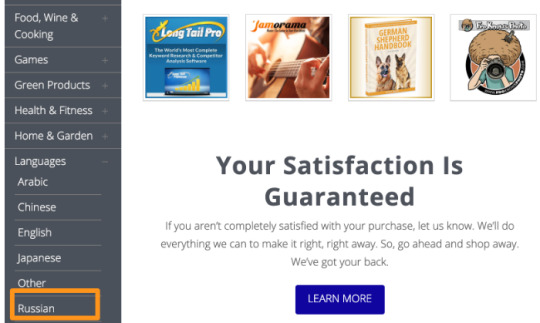
Unfortunately, there is only one product for sale in this category.
That isn’t promising. If it was a profitable niche, there would probably be more options.
However, when I click on “Languages”, I see lots of courses. And if I follow tip #1, searching for “best language hacking blogs” brings back a strong list of competitors, such as Fluent in 3 Months.
So, “Russian” might be too niche.
But “language” learning could be a niche worth pursuing.
Key Takeaways
If you’re completely new, start a niche website for one of your hobbies or passions.
If you know what you’re doing, choose a profitable niche.
To find profitable niches, do a Google search to see if there are any sites ranking in the SERPs for your target topic. If there are, snoop around to see if they’re monetizing.
You can also use affiliate networks like ClickBank to find interesting niches to enter.
Further Reading
How To Find A Niche That Is Guaranteed To Be Profitable by Authority Hacker
Find Your Niche With My Secret To Finding Profitable Niche by Matthew Woodward
How To Find A Profitable Niche For Your Blog (7 Simple Steps) by Cloud Living
Back to Top
2. Setup Your Site
Done with niche selection?
Great. Now it’s time to setup your site.
There are four things you need when you first get started:
Domain
Hosting Provider
Content Management System (CMS)
Theme (Plus Some Essential Plugins)
Now, don’t worry if you’re not tech-savvy. I wasn’t great when I started too. I’ll be running through what each of them are, so you can get started fast.
How I Setup My Site (and How I Would Do it Differently Today)
See this?

This is a domain. Think of your domain as the address to your house.
A lot of beginners get stuck on this phase. They procrastinate, hoping to find a perfect domain name.
The hard truth? There’s no such thing.
For us, we wanted a domain that was memorable but self-explanatory. We wanted people to understand what the site was about immediately.
That meant we needed the word “breakdance” in our domain. After brainstorming a few ideas, and consulting the thesaurus, we settled on breakdancedecoded.com.
Don’t spend all your time deciding on the domain. Just make sure it is:
Short and memorable;
Easy to spell. Imagine if someone asked you for your domain in real-life. Would it be easy for someone to remember and type it in later, or would they struggle to remember?
Includes your niche. This tells the visitor right away what your site is about.
If you’re stuck, you can use a tool like Domain Name Brain to give you some ideas:
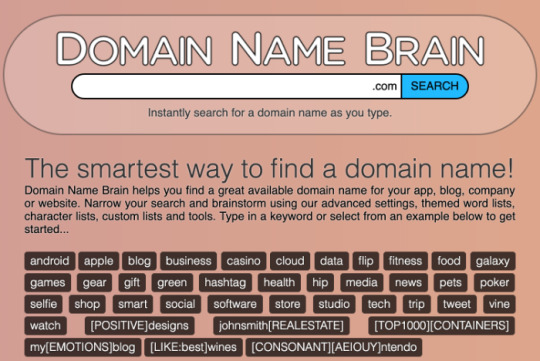
Once you’re done deciding the name, check if it is available in a domain registrar like NameCheap (affiliate link) or Hover.
Next: A Hosting Provider
To have a house, you need to have the architecture to hold it.
Your host is that architecture.
A hosting provider allows your website to be accessible on the Internet.
Since we weren’t technically-savvy, we followed a friend’s instruction and got our hosting from WPEngine.
In hindsight, that wasn’t a good decision. WPEngine is great, but it is pretty costly for a beginner site that won’t get that much traffic.
If you’re starting out, you probably won’t be getting very much traffic. So, it’s better to get a cheaper host.
There are plenty of hosting providers out there. Take a look around. Smart Blogger recommends SiteGround (affiliate link), so they’re one option to consider.
Editor’s Note:
I would be remiss if I didn’t mention Jon’s in-depth guide on web hosting.
Before you choose a hosting provider, be sure to check out WordPress Hosting: A Brutally Honest Guide That’ll Save You Money.
Content Management System (CMS)
A content management system is an online tool that enables you to create and manage your content (e.g. blog posts). WordPress is the most popular CMS, but there are other alternatives too.
Since we were using WPEngine, we turned to WordPress as our blogging platform.
As you’ll see later on, the biggest traffic channel for a niche site will likely be Google. As such, you should choose a CMS that is SEO-friendly.
Most search engine optimization (SEO) experts recommend WordPress, and it’s the CMS I recommend too.
Editor’s Note:
The steps for installing WordPress will depend on your hosting provide and your particular situation.
But don’t worry.
Chances are excellent our massive, step-by-guide on How to Install WordPress in 5 Minutes or Less will be able to walk you through the tricky parts.
Once you’re done with the installation, you’ll need a theme.
A theme is a template that defines the appearance of your site. (Think of it like the design of your house).
For our theme, we chose Genesis.
Genesis isn’t the best-looking theme around, but at the time we were looking for efficiency and ease of use. (Plus, we weren’t that great with design.) We also figured that we could upgrade to a better theme later on, if we got more successful.
Genesis Theme in Action
With its simplicity, Genesis was a great theme for us. If you’re more design-savvy, feel free to pick another theme.
Smart Blogger recommends Elegant Themes (affiliate link), but you can also browse through the selections in ThemeForest.
Once you’re done, install these two free plugins:
Akismet. Helps you combat comment spam.
Yoast SEO. Helps you easily optimize your on-page SEO.
If you want more WordPress plugins to install, check out this list of time savers.
Key Takeaways
Don’t get analysis paralysis when it comes to your domain name. Choose one that is memorable, easy to spell, and includes your niche.
Since you won’t get very much traffic initially, start with a cheaper, flexible host, like SiteGround.
Choose WordPress as your CMS.
Further Reading
WordPress SEO: The Only Guide You Need by Viper Chill
WordPress SEO: A Practical (and EASY) Guide by Ahrefs
Back to Top
3. Do Topic Research
Your foundation is set.
It’s time to start getting traffic to your site.
How I Did My Topic Research
Now, at this point, most bloggers make the same mistake:
They write about whatever tickles their fancy.
I know because I did the same thing.
I brainstormed topics I thought would resonate with my audience, and then I wrote about them. The only reason I got away with it was because I was a breakdancer writing to other breakdancers.
I knew the topics that would interest my audience because I was a part of that audience.
But if you’re working in a niche that is unfamiliar to you, you can’t just write about anything you want.
Those topics won’t resonate and you won’t build an audience.
Worse:
Your content won’t rank in Google, which means no traffic will come to your site.
How I Would Do My Topic Research Today
For most niche sites, the best way to get traffic is SEO.
SEO is an acquisition channel that will grow passively. As long as you are ranking well for the keywords you’re targeting, you will get passive traffic.
Compare that with other channels.
You could experiment with paid ads (for example, Facebook ads), but as soon as you stop the campaign or run out of money, your traffic dries up immediately.
The same goes for social media. You have to either build up a large audience (difficult) or bank on viral hits (also difficult). And as soon as you stop tweeting and sharing, whatever traffic you were getting will disappear.
Search engine traffic doesn’t stop. It keeps going. Even when you’re sleeping.
If you want search traffic, you need to write about topics that people are searching for. In other words:
You need to create content for topics with search traffic potential.
In SEO parlance, this is known as keyword research.
Here are a few ways you can do it:
Use a Keyword Research Tool
The easiest way to get started is to use a keyword research tool.
Enter any seed keywords related to your niche into a keyword research tool, and it will generate hundreds of different ideas you can target.
For example, here’s a free keyword tool called AnswerThePublic:
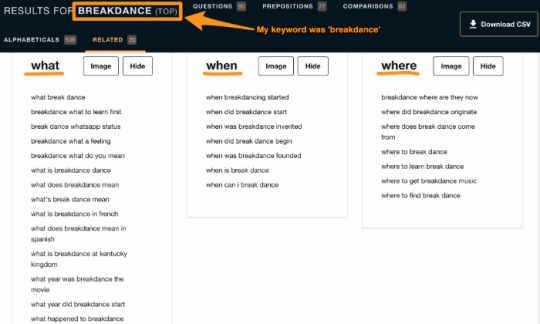
AnswerThePublic generates ideas for you based on different categories: questions, prepositions, comparisons, alphabeticals, etc.
There are plenty of other free tools out there, like:
Google Keyword Planner
Wordtracker Scout
Keywords Everywhere
Take your pick.
One of the most important metrics SEOs look at when doing keyword research is search volume. Essentially, search volume is the amount of searches per month for a keyword.
The problem with a free tool is that, while it’s free, it usually has either missing or incomplete data.
As such, you might want to consider using a professional keyword tool like Ahrefs’ Keywords Explorer (affiliate link).
You can access it using the Ahrefs’ $7 for 7-days trial.
Enter a seed keyword into Keywords Explorer, and it will generate thousands of keyword ideas, plus all sorts of relevant SEO metrics:
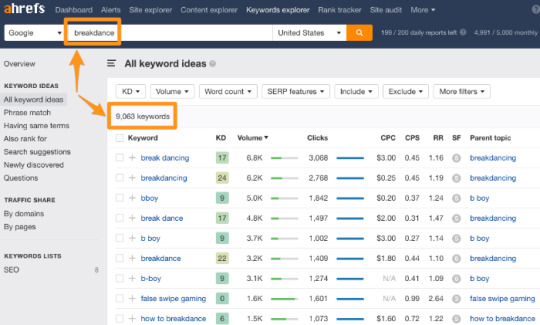
Here’s a quick explanation of everything you’re seeing in the above screenshot:
Keyword Difficulty (KD). Ahrefs’ Keyword Difficulty metric gives you an estimate of how hard it would be to rank in the Top 10 search results for a given keyword.
Search volume (volume). This shows you how many times per month, on average, people in a given country search for your target keyword.
Clicks. This shows you the average monthly number of clicks on the search results that people make while searching for the target keyword.
Cost-per-click (CPC). This shows you the average price that advertisers pay for a click on their ad in Google’s paid search results for a target keyword in a given country.
Clicks-per-search (CPS). This shows you the average number of clicks people perform after searching for a given keyword.
Return Rate (RR). This shows you how often the same person searches for a given keyword over a 30-day period.
SERP Features (SF). This refers to how many Google’s SERP Features appear in the search results for this keyword.
Parent Topic. This shows you a better topic you can target as opposed to the keyword you’re entered.
Lurk in Communities
There are communities for every imaginable topic out there.
Love the TV show Brooklyn Nine-Nine? There’s a subreddit for that. Enjoy discovering new products? Well, that’s how ProductHunt was formed.
You name it, they have it.
People gather in these communities to ask questions, discuss trending news, get recommendations, and so on.
Translation: these communities offer a wealth of topics for your niche site.
When we started, we hung out a lot on r/bboy, a subreddit for breakdancers. This was where we got our initial list of topics:
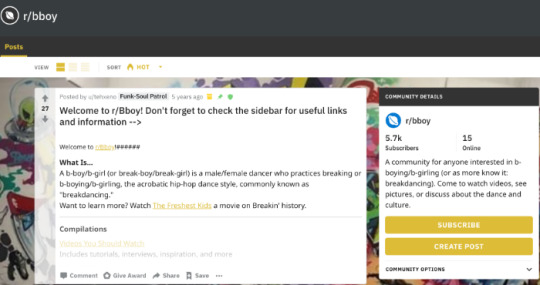
You can do the same too.
Do a search and find all the communities related to your niche. You can find them in places like:
Reddit;
Quora;
Facebook;
Slack;
Forums (yes, they still exist);
And much more.
To find out if these topics have search traffic potential, you can install the Chrome/Firefox extension Keywords Everywhere on your browser.

You can also enter these topics into Keywords Explorer.
Ahrefs will show you all the SEO metrics, plus suggest a better topic for you to target (“Parent Topic”).
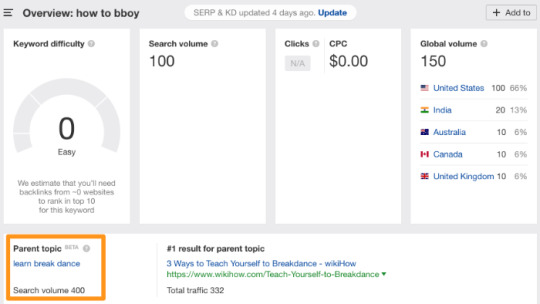
Figure Out What Your Competitors are Ranking for
Your competitors have done the hard work for you. They’ve been blogging and ranking in Google.
Your job? Borrow generously.
Find out what’s working for them, and then replicate those topic ideas.
Most sites feature their best-performing posts on their blogs, usually in a sidebar:
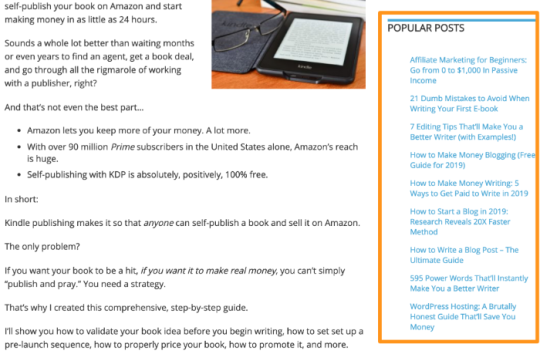
You can easily see which keywords they’re optimizing for.
For example, the post 595 Power Words That’ll Instantly Make You a Better Writer is obviously optimizing for the keyword “power words.”
If you’re unsure, you can click through to the post. If they’re SEO-savvy, they would have optimized their URLs for the target keyword.

Of course, the best way is to use a tool like Site Explorer.
Enter your competitor’s domain into the tool and go to the “Top Pages” report, where you’ll see all the pages sending them the most search traffic:
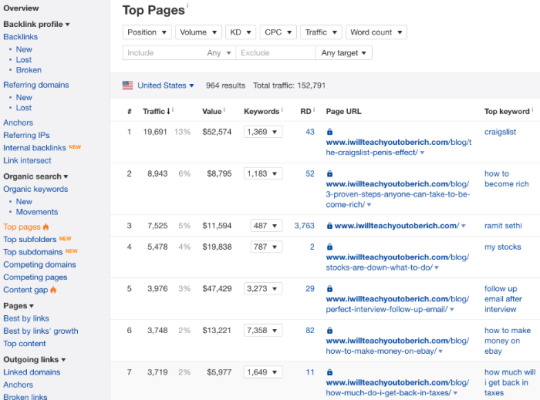
Key Takeaways
To get search traffic to your niche website, you need to target topics that people are searching for. To do this, you need to do keyword research.
You can either use a free keyword tool or a paid, professional version.
The paid version will also allow you to check all the keywords your competitor sites are ranking for.
To find out what your readers are searching for, you can also lurk in communities to find widely-discussed topics.
Further Reading
What to Blog About: 3 Steps to Mapping out Your Ideas in a Logical Way by Jon Morrow
Keyword Research: The Definitive Guide by Backlinko
How to Do Keyword Research for SEO by Ahrefs
Back to Top
4. Create Your Content
Jon Morrow is right:
“The best content is king.”
If you want to rank in Google, build an audience and compete with others, you have to create epic content.
You have to publish the best article ever written about those topics with search traffic potential.
The posts have to be detailed.
They have to be in-depth.
They have to answer every single question about that topic.
How I Created My Content
When we began our niche site, we were already huge fans of the detailed, long-form articles published by Smart Blogger and Backlinko.
So, we sought to emulate them.
We even published a 17,000-word article on how to get started with breakdancing.
It was our most successful article, but it took us almost a month to write.
You might be wondering:
“If you’re writing such long articles, how can you publish something every day?”
Answer: you don’t.
Publishing every day is a fool’s game.
What you should do is to focus on quality, not quantity.
If you have to publish less, so be it. Don’t sacrifice the depth of your article on some arbitrary content schedule.
(For us, it was impossible to stick to a schedule, as we had full-time jobs.)
You want to be known for the quality of your work — not how quickly you pump out new articles.
That being said, what does it mean to create great content?
When we started, all we knew was we needed to create something in-depth. We weren’t writers and had no blogging experience.
In short, we had no way to measure and define “great content.” We just went with our instincts.
Today, things are different. After reading and writing so many pieces of content, I can see which articles can be classified as great, and which can’t.
How I Would Create My Content Today
I no longer need to rely on my instincts. I know what “great content” is and what it must embody. It needs the following three characteristics:
Characteristic #1: Quality
Quality is subjective, of course.
How then do you know you’ve created something worth shouting about?
In my experience, quality consists of three factors:
Design. Is the website design great? Is it easy-to-read? Are the images beautiful? Or is the site cluttered with hundreds of banner ads, each distracting your reader from the main purpose, which is to consume the content?
Content. Does the article flow? Is it interesting, entertaining, and useful? Or is the article full of grammatical and spelling errors that makes reading it off-putting?
Usefulness. Does the article actually solve a problem? Does it discuss the topic in-depth? Or is it merely beating around the bush?
If the content you produce meets these three factors, it’s great content.
Characteristic #2: Uniqueness
There are thousands, if not millions, of articles published on similar topics each and every day.
Why would someone choose your article over the others?
The best way I’ve found to create unique content is to write from personal experience.
Pro Tip: This is how Smart Blogger became such a powerhouse in the blogging world. When Jon writes about blogging, it comes from his years of experience. When a guest author is invited to write about a topic, they’re chosen because they have had experience in those areas.
Characteristic #3: Authority
Do you want to learn astrophysics from a Caltech physicist, or your next-door neighbor?
Of course, it’s the Caltech physicist. (Unless, you once lived next to Richard Feynman.)
Your readers are the same way.
No matter the topic, they want to learn from an authoritative source.
If you’re the expert, great! Carry on.
But what if you aren’t?
Get the experts to help you. Be the journalist. The scribe. There are plenty of experts with great knowledge, but insufficient ability to communicate that knowledge.
You can be the go-between.
Interview them. Curate their thoughts, research and expertise. You can even invite the expert to write an article for you.
For example:
Tim Ferriss. Tim doesn’t have expertise in every topic in the world, but he touches lots of topics. He does this by inviting experts to contribute to his books.
Pro Tip: This is also the reason why Smart Blogger succeeded when many failed. If Jon doesn’t have experience in something (e.g. Kindle Publishing), he doesn’t write the article. Instead, he invites someone with experience to do it.
If you read our epic guide to breakdancing, you’d see it checked all three aspects we just covered:
Quality. While it wasn’t the best-designed post, we formatted it well and added a header image (done on Canva). We even added a Table of Contents!
Uniqueness. We wrote the entire thing based on our years of experience in dance. We told plenty of stories that were highly unique to what we had seen and observed.
Authority. All of us had at least 7-8 years of breakdance experience.
Key Takeaways
If you want to rank in Google, make sure you create great content.
Focus on quality — not quantity or satisfying some “content calendar.”
Great content has three characteristics: quality, authoritativeness, and uniqueness. You need to do all three.
Further Reading
How to Write a Blog Post in 2019: The Ultimate Guide by Liz Careathers
Demystifying Epic Content: How to Actually Create It (Not Just Jabber About How Important It Is) by Sonia Thompson
How to Write a Blog Post in 9 Steps (That People Actually Want to Read) by Ahrefs
Back to Top
5. Promote Your Content
Do you want to know the greatest lie in the content marketing world?
It’s this adage:
“If you build it, they will come.”
Nothing can be further from the truth.
Think about it.
According to the latest stats, there are 4 million blog posts published every single day. That’s a lot of noise.
That also means there is an extremely low chance that somebody will randomly stumble upon your site.
If you want traffic, you have to be proactive. You have to promote your content. You have to build links.
How I Promoted My Content
We focused on three promotion techniques:
Technique #1: The “Eager Sneezers” Technique
In a post published in 2015, Bryan Harris shared how he started an email list from scratch and got 205 subscribers in 48 hours.
The technique he used? “Eager Sneezers.”
Ignoring the fancy name, it’s essentially reaching out to your friends and inviting them to join your email list.
Bryan’s biggest takeaway was your friends want to help you (so let them).
We used a variation of this idea to get our early traction.
After publishing a post on breakdance music, we reached out to multiple friends to help share it.
Fortunately, as we were breakdancers ourselves, we had a number of breakdancer friends who were more than happy to help:
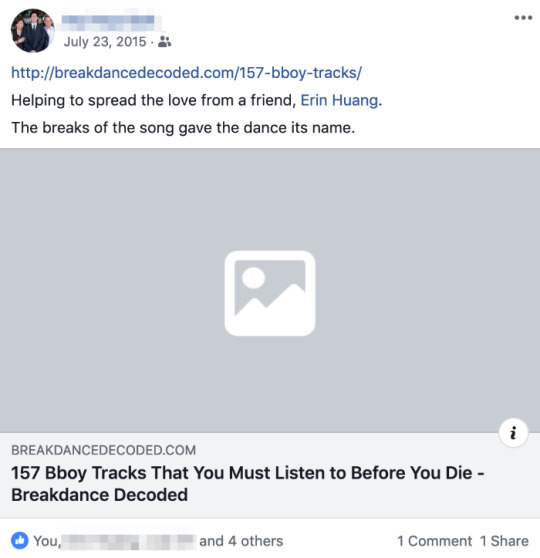
Technique #2: Community Content Promotion
Remember the communities you joined earlier (where you were “lurking” for ideas)?
They’re great for content promotion too.
Here’s one example of what we did:
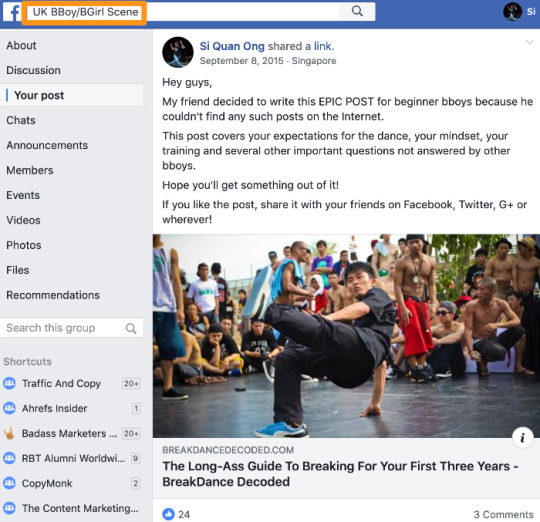
Now, this is not an excuse for you to strut into someone else’s community and start spamming links to your content.
Online communities exist for people to have meaningful conversations about a particular topic. Link spam defeats that purpose.
Plus, you’ll likely get booted out of the group.
The only reason I was able to promote my content in a group like this was because I was already an active member. I was participating in discussions, asking questions, and commenting.
I knew what kind of content the community would appreciate, which was why I was able to share it.
So, before you start dropping links to your content in a group, make sure you are active and understand the group’s rules.
Technique #3: Outreach to People You’ve Mentioned in Your Content
If you’ve written an epic piece of content, you’ve likely linked out to sources or quoted experts.
Let them know!
For example:
In our post, we listed 157 songs a breakdancer must listen to. This meant 157 different people we could email.
So, we did. And it resulted in one of the featured artists sharing our post on Facebook:
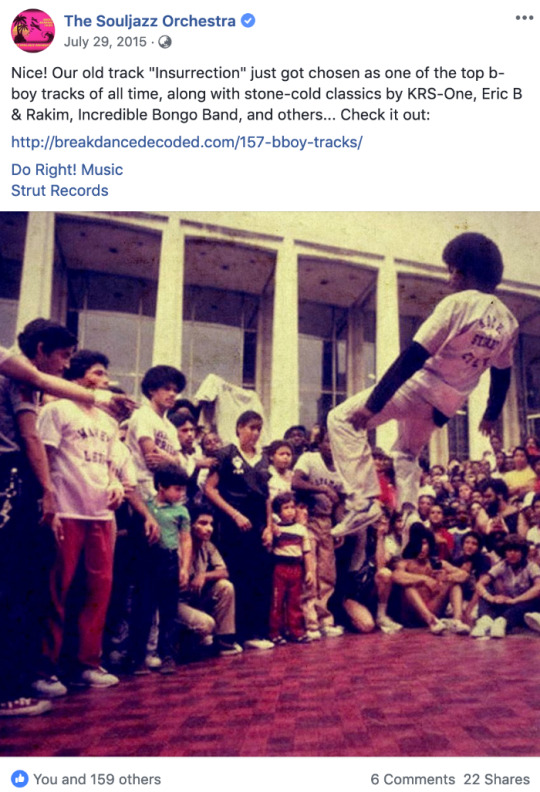
How I Would Promote My Content Today
According to a survey of 1,117 bloggers, higher-income bloggers put more emphasis on promoting their content than lower-income bloggers.
Translation: if you want to succeed, you have to keep on promoting your content.
If I were to create a new niche website, I would add these content promotion strategies into my toolkit.
Strategy #1: Outreach to People Who Published Articles on the Same Topic
Since they’ve written on that topic before, there is a higher probability they’ll be interested in seeing your post.
To find these people, simply enter the topic of your article (remember to try variations!) into Google. Collect the list of articles that appear in the SERPs.
Then find their email address and reach out.
Alternatively, you can use a tool like Ahrefs’ Content Explorer, a search engine for web content.
Enter the topic into Content Explorer, do some filtering (like “English only”), and export the list.
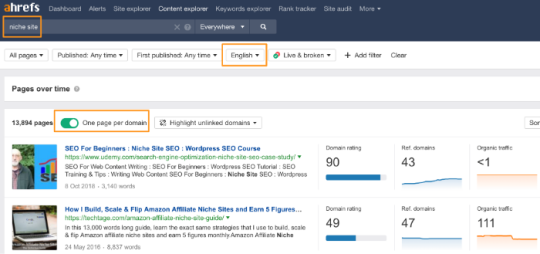
You now have a huge list of sites to reach out to.
All that’s left is to write the email.
Here are a few tips to help you write a compelling email:
Keep it short. Most people are busy. You improve your chances of getting your emails read if it’s short and to the point.
Tell them what’s in it for them. Everyone looks out for #1. Provide value upfront and let them know what they can get out of it.
Personalize the email as much as possible. People can tell when an email is a template. If they think it’s a template, they’ll delete it without reading.
Ask wisely. People dislike being told to do something. Don’t be pushy. If you’re asking for a link, suggest the idea gently.
You can also read this in-depth guide about blogger outreach.
Strategy #2: Guest Blogging
Guest blogging is a tactic where you write a post for another website (instead of yours).
In exchange for your “free” article, the owner gives you:
A few links back to your site (either within the body content or inside the author’s bio);
Exposure to their audience;
Referral traffic.
Those are just the immediate benefits. Guest blogging also allows you to build relationships with influencers, or even grow your email list.
The biggest challenge with guest blogging is finding blogs willing to accept your guest posts.
To increase your chances of being accepted, look for sites that are already accepting guest posts.
You can find these sites via Google search operators. Here are a few examples:
[your_topic] “write for us”
[your_topic] “become an author”
[your_topic] “guest post”
[your_topic] “guest article”
[your_topic] inurl:contribute
These sites usually have a “write for us” page, so all you have to do is to follow their instructions.
You can also look for these opportunities in Content Explorer. The reasoning: if a blog has written about a topic before, there is an increased probability they would cover it again.
Enter any word/phrase from your niche into Content Explorer.
Check the “one article per domain” box to get a list of unique domains you can potentially write for:
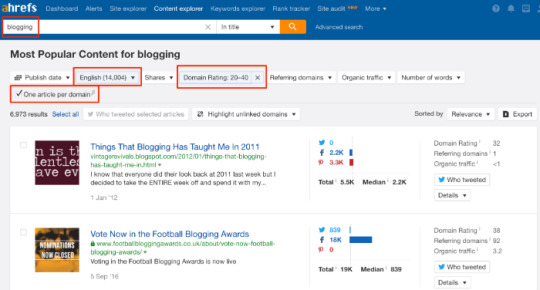
Some of these sites may not have an obvious “write for us” page. But, most blogs will accept a guest post if your pitch is good enough.
Key Takeaways
If you want traffic, you have to promote your content.
To kick-start your site and get some initial traction, try the “Eager Sneezers” technique.
You can also promote your content in communities.
If you’ve mentioned anyone in your posts, reach out and let them know.
To take it to the next level, try guest blogging and reaching out to people who’ve written about similar topics.
Back to Top
6. Grow Your Email List
Study the best sites in any niche, and you’ll notice one thing:
They all build an email list.
An email list is powerful because you can do almost anything with it. You could:
Survey your subscribers to get content ideas;
Ask them for feedback;
Test monetization ideas;
Sell something.
The possibilities are virtually endless.
How I Built My Email List
Because we were observing these huge sites, we understood the power of the email list very early on. In fact, we obsessed over collecting as many emails as possible.
We tested all kinds of strategies on the site.
Welcome Mats:
Content Upgrades:
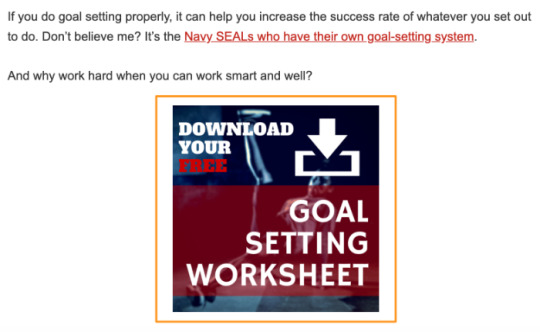
We even turned our homepage into an email collection machine:
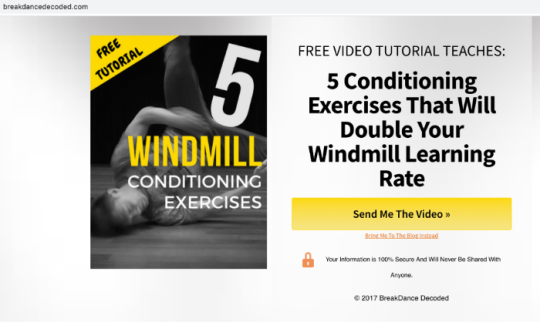
How I Would Build My Email List Today
In hindsight, we were too aggressive with our email collection.
We were so concerned with the number of emails on our list, the quality of our list suffered.
We should have focused on user experience and only placed email sign-up forms where relevant.
Over the years, Jon and the rest of the Smart Blogger team have written tons of guides on email list building, so I won’t delve too deeply into this topic.
You can check out the different resources here:
The Ultimate List-Builder’s Resource Guide: 109 Links to Double or Even Triple Your Subscribers
9 Irresistible Incentives That’ll Grow Your Email List Like Crazy
10 Creative Places for Opt-In Forms That’ll Supercharge Your Signups
9 Plugins for Growing Your Email List That Work So Well It Feels Like Cheating
The Quick and Dirty Guide to Creating Your “Bribe to Subscribe” in Record Time
Key Takeaways
Build a list! It’s the most important thing you need to do.
Test different methods for collecting emails on your site.
But don’t neglect user experience. Don’t cram 100 pop-ups on your site just so you can get a few more subscribers.
Back to Top
7. Experiment with Monetization
What’s the purpose of a niche site?
To make money!
As you start gaining traction on your site, and gaining a few subscribers, you can start to look into monetization.
How I Monetized My Site
At BreakDance Decoded, we experimented with a few different strategies.
Strategy #1: Patreon
Patreon is a membership platform where fans can “fund” content creators. You can create separate tiers on Patreon to reward different levels of loyalty.
Back then, Patreon was a relatively new-ish platform. We saw that a few legitimate artists and creators were generating significant amounts of money on the platform, so we gave it a shot.
This was our Patreon page:
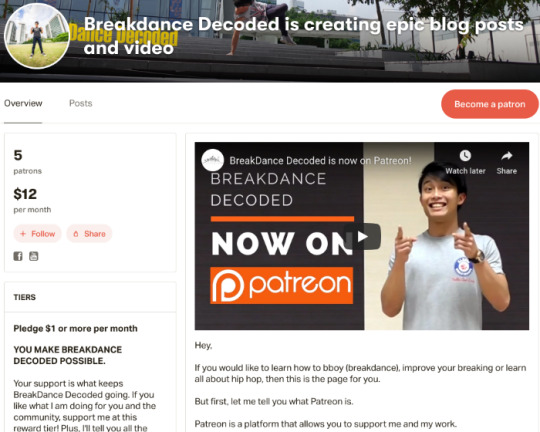
No matter how hard we marketed ourselves, the best we did was $50 per month on Patreon.
That’s not to say Patreon doesn’t work.
There are plenty of successful Patreon artists, like Kurzgesagt, who has over 12,000 patrons supporting his work:
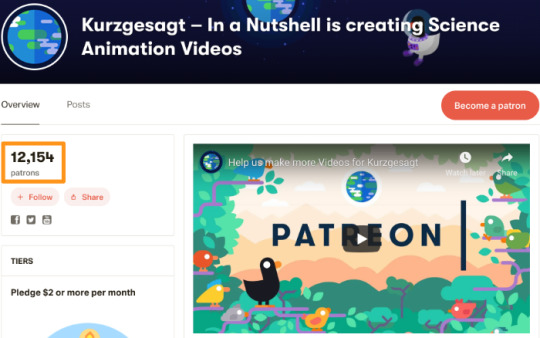
Your results may vary.
Strategy #2: YouTube AdSense
In addition to our website, we were also running a YouTube channel. So, we decided to see if we could make enough money from YouTube.
Yes, we dreamed of being the next PewDiePie.
These were our results:

It was decent, but it wasn’t enough for a “passive income” source.
Plus, our niche was too “specific”, so we probably didn’t generate enough views to make financial sense.
Strategy #3: Coaching
One of Jon’s recommendations was to sell video or phone coaching as a quick way to monetize your site.
We took it seriously.
We sent an email to our list, telling them we were available for personal breakdance coaching. At the time, this was a relatively new concept to the niche, so we weren’t sure if it would work out.
Surprisingly, someone took us up on it.
Strategy #4: Online Courses
By 2025, the e-learning industry will grow to about $325 billion in size.
This probably explains why most popular blogs monetize via online courses.
However, our biggest concern (back then) with an online course was the time and effort it took to create a great one. Plus, we weren’t sure if there were any demand for an online breakdance course.
The notion of spending considerable time, effort, and money into creating a course no one wanted didn’t sound appealing.
But after testing all the different strategies listed earlier, creating an online course seemed to be the most viable option.
So, we decided to launch a MVP (Minimum Viable Product).
We sent a survey to our email list, asking them for their #1 challenge.
From there, we came up with a hook we thought would interest our audience:
Hey friend,
Don’t you feel like breaking has limited support and not enough is done to help you improve?
Sure, there are tons of studios out there, and jams have become widespread.
But not every breaking tutorial fixes the problem effectively. Not everyone gets access to the information and knowledge from other bboys. Not every country or state has a strong breaking scene.
This lack of environment for growth sucks, because so many potential bboys and bgirls around the world deserve a chance to learn breaking.
Ideally, a bboy/bgirl’s progress should only be ‘limited’ by their own effort. Not the environment.
As a first step to tackle this problem, I’ve created a 1-minute survey to get to know you better (don’t worry it’s 5 simple questions, no right or wrong answers here.)
So click this link to fill up our quick survey!
Thanks for helping me to understand your breaking views. It will go a long way for both you and me 🙂
While we waited for feedback, we created an outline for a potential 9-week course.
Using the email hook and the outline, we crafted a 5-day email sequence modeled after Ramit Sethi’s successful launches.
Not knowing what to charge, we decided on an arbitrary sales price of $37. For the test to be successful, we told ourselves that we needed at least 10 sales.
As we weren’t technically savvy, we had no idea how to collect orders online. We also didn’t have money to invest in a shopping cart software.
So, we kept it simple:
We created a PayPal link.
Then we activated the 5-day campaign by sending our subscribers a launch email.
To our surprise, we actually managed to sign up 12 students.
Our test was successful!
The only issue? We now had to actually create the course.
Once again, instead of investing in some complicated course software to launch it, we decided to do it the easy way:
Facebook had just launched its “Live” feature and was heavily promoting it.
We decided to use it.
We created a closed Facebook group, sent an email to our 12 students, and invited them to join the group:
Our Closed Facebook Group
Then we filmed each lesson by using Facebook’s Live feature.
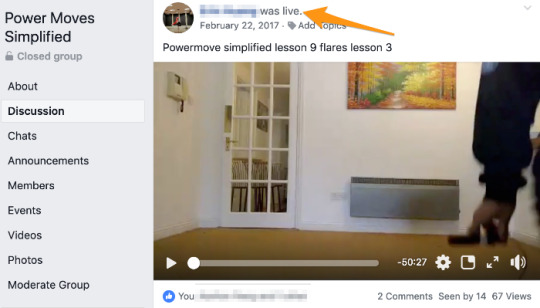
Besides some technical issues (like audio), we received rave reviews for our course.
Takeaway:
Don’t let perfectionism stop you from launching. People buy courses for the information, not the software you use or how perfect it looks.
What I Would Do Differently Today
I wouldn’t change a thing.
Online courses worked for me then, and it’s the monetization strategy I would use today.
That said…
Your results may vary.
It’s a good idea to play around with different monetization methods to see what works best for you. Even if you find a cash cow, always be looking at different ways you can diversify your income stream.
Otherwise, you’re asking for trouble.
Nomadic Matt has a blog that receives 1 million visitors each month, but as shared in his interview on Noah Kagan Presents, if he had continued with the same business model he had when he started (i.e. selling links), his business would have been dead in the water by now.
Key Takeaways
Test different monetization strategies and see which one works out best for you.
Patreon, online coaching, and online courses are all viable methods to generate revenue.
You can also consider other methods like affiliate marketing, selling eBooks, and so on.
Further Reading
How to Make Money Blogging (Free Guide for 2019) by Jon Morrow
Affiliate Marketing for Beginners: Go from 0 to $1,000 In Passive Income by Leanne Regalla
How to Make Money Writing: 5 Ways to Get Paid to Write in 2019 by Glen Long
Back to Top
Are You Ready to Create a Profitable Niche Website?
This wasn’t a case study about how successful I am or how many Lamborghinis I now own.
It’s the opposite.
My site wasn’t successful by any means.
Instead of sipping mojitos at the beach, I’m still working out of an office.
But that’s because I didn’t know then what I know now.
Now I know better. Now I know what to do. And now so do you.
It is possible to build a niche website and monetize it.
So what are you waiting for?
Paradise is waiting.
About the Author: Si Quan Ong works in marketing and customer success for Ahrefs, the SEO toolset that helps you grow your search traffic, research your competitors and dominate your niche. If not evident by now, he also breakdances on the side, and has a dream to visit 100 countries. Follow him on Twitter to learn more about his misadventures.
The post How to Build a Niche Website (Step-by-Step Case Study) appeared first on Smart Blogger.
from Internet Marketing Tips https://smartblogger.com/niche-website/
0 notes
Text
How to Build a Niche Website (Step-by-Step Case Study)

Ever dreamed of lying on the beach while earning tons of passive income?
I did.
I wanted to build my own business that generated thousands of dollars while I slept, partied, and traveled around the world.
So, in 2015, my friends and I created a niche website to teach beginners how to breakdance.
Sadly, we never made enough money to quit our jobs and move to paradise.
But here’s the thing…
Though we weren’t successful, the experience taught me a lot about how to build a niche website, market it, and monetize it. And combined with the knowledge I’ve gained working at Ahrefs, I now know the keys to success.
In this post, I’m going to show you what I’ve learned:
What I did right, what I did wrong, and what I would do differently if I created a new niche site today.
Back to Top
We’ll start with a quick definition, followed by a few examples…
What is a Niche Website?
A niche website is a website that caters to a small segment of a large market by focusing on a common, specific interest.
My website, BreakDance Decoded, was a niche website. It specifically targeted breakdancers, which is a small part of the much larger “dance” market.
Other examples of niche sites are Mr. Money Mustache (focusing on saving and budgeting in the personal finance market) and Kopywriting Kourse (focusing on copywriting in the marketing/business market).
There’s a common misconception that a niche website is a small site. This isn’t true.
“Niche” refers to the segment of the market, not the size of the website.
A site can be niche and still have thousands of pages covering a variety of topics related to the niche.
Case in Point
Nerd Fitness is a niche website that writes about fitness for nerds. Even though it’s only targeting a specific type of persona, the site has hundreds of blog posts ranking for important keywords in Google.
In general, a niche website is an information website. It either produces or sells information that solve problems (e.g. courses, ebooks, etc.).
It may eventually pivot to other monetization models like e-commerce, but the core engine behind the site is information.
Now that you know what a niche site is, let’s take a look at how you create one:
Back to Top
How to Create a Niche Website in 2019 (Step-By-Step)
Choose Your Niche
Setup Your Site
Do Topic Research
Create Your Content
Promote Your Content
Grow Your Email List
Experiment With Monetization
1. Choose Your Niche
For many aspiring bloggers, niche selection is one of the most challenging dilemmas they face when starting a blog.
They either have too many ideas, or — worse — they have no idea what kind of site they should build.
It doesn’t help that there’s lots of contradictory advice out there: some people suggest you start with your passion, while others say you should choose a niche that’s profitable.
How I Chose My Niche
Personally, I started with my passion.

Not counting my job, breakdancing was the activity I spent the most time doing. So, setting up a niche site that would educate people about breakdancing was a no-brainer for me.
If you’re completely new to building a site and you just want to learn how things work, I would recommend you start with your passion.
Why?
Because growing a website is hard work.
But if you’re creating content on a topic you’re passionate about, you’ll be able to find the motivation to persist on those days you feel like quitting.
(And trust me, those days will be frequent.)
How I Would Choose My Niche Today
Today, I would choose a profitable niche.
What’s that?
It’s a niche with a large audience that buys things.
And that’s what you want:
A market where people are buying, buying, and buying.
While it was fun to write about breakdancing, it was a tough market to crack. When we started, there weren’t any other niche sites about breakdancing. Our competing sites were mostly e-commerce stores selling apparel for breakdancers.
In hindsight, that should have been a warning sign.
If there are no competitors in the SERPs (Search Engine Results Pages), you should be concerned.
Competitors = Viable Market
Competition is healthy. It’s a sign the market is worth entering. It’s a sign there’s money to be made.
We should have listened.
To help you avoid the mistake we made, here are a couple tips to help you find profitable niches:
Tip #1: Brainstorm + Snooping Around
Sit down and brainstorm some niches you’re interested in pursuing. Then, do a quick Google search to see if there are any sites dedicated to them.
You can search for “best [niche] blogs” to get started (e.g. “best breakdancing blogs”).
And once you’ve found a few potential competitors in your niche, “snoop” around their site and see how they’re monetizing.
If they have a variety of products, it could be a good niche.
For example, let’s say I am interested in the paleo niche. A quick Google search for the “best paleo blogs” brings me to this site:

Looking around, I can see Diane monetizes her site in a variety of ways:
Books
Programs/Courses
Amazon Affiliates
Certifying other health coaches
Etc.
Seems like a good niche!
Tip #2: Browse Affiliate Marketplaces
Alternatively, you can also look into affiliate networks like ClickBank and Amazon Associates. These are middlemen networks that connect bloggers and niche site owners with companies offering affiliate marketing opportunities.
You have an audience, they have a product. Perfect match!
Affiliate networks are ideal because:
These products are being bought by people interested in different niches;
They have a variety of categories you can browse.
Just go through them until you find products you’re interested in.
Here’s an example:
Right now, I’m learning Russian. So, I might be interested in starting a niche site about the Russian language.
And lo and behold, ClickBank has a category for the Russian language. Cool!
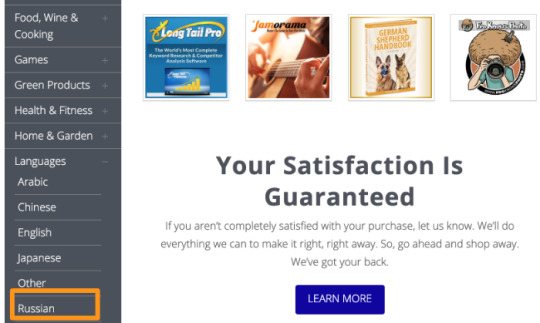
Unfortunately, there is only one product for sale in this category.
That isn’t promising. If it was a profitable niche, there would probably be more options.
However, when I click on “Languages”, I see lots of courses. And if I follow tip #1, searching for “best language hacking blogs” brings back a strong list of competitors, such as Fluent in 3 Months.
So, “Russian” might be too niche.
But “language” learning could be a niche worth pursuing.
Key Takeaways
If you’re completely new, start a niche website for one of your hobbies or passions.
If you know what you’re doing, choose a profitable niche.
To find profitable niches, do a Google search to see if there are any sites ranking in the SERPs for your target topic. If there are, snoop around to see if they’re monetizing.
You can also use affiliate networks like ClickBank to find interesting niches to enter.
Further Reading
How To Find A Niche That Is Guaranteed To Be Profitable by Authority Hacker
Find Your Niche With My Secret To Finding Profitable Niche by Matthew Woodward
How To Find A Profitable Niche For Your Blog (7 Simple Steps) by Cloud Living
Back to Top
2. Setup Your Site
Done with niche selection?
Great. Now it’s time to setup your site.
There are four things you need when you first get started:
Domain
Hosting Provider
Content Management System (CMS)
Theme (Plus Some Essential Plugins)
Now, don’t worry if you’re not tech-savvy. I wasn’t great when I started too. I’ll be running through what each of them are, so you can get started fast.
How I Setup My Site (and How I Would Do it Differently Today)
See this?

This is a domain. Think of your domain as the address to your house.
A lot of beginners get stuck on this phase. They procrastinate, hoping to find a perfect domain name.
The hard truth? There’s no such thing.
For us, we wanted a domain that was memorable but self-explanatory. We wanted people to understand what the site was about immediately.
That meant we needed the word “breakdance” in our domain. After brainstorming a few ideas, and consulting the thesaurus, we settled on breakdancedecoded.com.
Don’t spend all your time deciding on the domain. Just make sure it is:
Short and memorable;
Easy to spell. Imagine if someone asked you for your domain in real-life. Would it be easy for someone to remember and type it in later, or would they struggle to remember?
Includes your niche. This tells the visitor right away what your site is about.
If you’re stuck, you can use a tool like Domain Name Brain to give you some ideas:

Once you’re done deciding the name, check if it is available in a domain registrar like NameCheap (affiliate link) or Hover.
Next: A Hosting Provider
To have a house, you need to have the architecture to hold it.
Your host is that architecture.
A hosting provider allows your website to be accessible on the Internet.
Since we weren’t technically-savvy, we followed a friend’s instruction and got our hosting from WPEngine.
In hindsight, that wasn’t a good decision. WPEngine is great, but it is pretty costly for a beginner site that won’t get that much traffic.
If you’re starting out, you probably won’t be getting very much traffic. So, it’s better to get a cheaper host.
There are plenty of hosting providers out there. Take a look around. Smart Blogger recommends SiteGround (affiliate link), so they’re one option to consider.
Editor’s Note:
I would be remiss if I didn’t mention Jon’s in-depth guide on web hosting.
Before you choose a hosting provider, be sure to check out WordPress Hosting: A Brutally Honest Guide That’ll Save You Money.
Content Management System (CMS)
A content management system is an online tool that enables you to create and manage your content (e.g. blog posts). WordPress is the most popular CMS, but there are other alternatives too.
Since we were using WPEngine, we turned to WordPress as our blogging platform.
As you’ll see later on, the biggest traffic channel for a niche site will likely be Google. As such, you should choose a CMS that is SEO-friendly.
Most search engine optimization (SEO) experts recommend WordPress, and it’s the CMS I recommend too.
Editor’s Note:
The steps for installing WordPress will depend on your hosting provide and your particular situation.
But don’t worry.
Chances are excellent our massive, step-by-guide on How to Install WordPress in 5 Minutes or Less will be able to walk you through the tricky parts.
Once you’re done with the installation, you’ll need a theme.
A theme is a template that defines the appearance of your site. (Think of it like the design of your house).
For our theme, we chose Genesis.
Genesis isn’t the best-looking theme around, but at the time we were looking for efficiency and ease of use. (Plus, we weren’t that great with design.) We also figured that we could upgrade to a better theme later on, if we got more successful.
Genesis Theme in Action
With its simplicity, Genesis was a great theme for us. If you’re more design-savvy, feel free to pick another theme.
Smart Blogger recommends Elegant Themes (affiliate link), but you can also browse through the selections in ThemeForest.
Once you’re done, install these two free plugins:
Akismet. Helps you combat comment spam.
Yoast SEO. Helps you easily optimize your on-page SEO.
If you want more WordPress plugins to install, check out this list of time savers.
Key Takeaways
Don’t get analysis paralysis when it comes to your domain name. Choose one that is memorable, easy to spell, and includes your niche.
Since you won’t get very much traffic initially, start with a cheaper, flexible host, like SiteGround.
Choose WordPress as your CMS.
Further Reading
WordPress SEO: The Only Guide You Need by Viper Chill
WordPress SEO: A Practical (and EASY) Guide by Ahrefs
Back to Top
3. Do Topic Research
Your foundation is set.
It’s time to start getting traffic to your site.
How I Did My Topic Research
Now, at this point, most bloggers make the same mistake:
They write about whatever tickles their fancy.
I know because I did the same thing.
I brainstormed topics I thought would resonate with my audience, and then I wrote about them. The only reason I got away with it was because I was a breakdancer writing to other breakdancers.
I knew the topics that would interest my audience because I was a part of that audience.
But if you’re working in a niche that is unfamiliar to you, you can’t just write about anything you want.
Those topics won’t resonate and you won’t build an audience.
Worse:
Your content won’t rank in Google, which means no traffic will come to your site.
How I Would Do My Topic Research Today
For most niche sites, the best way to get traffic is SEO.
SEO is an acquisition channel that will grow passively. As long as you are ranking well for the keywords you’re targeting, you will get passive traffic.
Compare that with other channels.
You could experiment with paid ads (for example, Facebook ads), but as soon as you stop the campaign or run out of money, your traffic dries up immediately.
The same goes for social media. You have to either build up a large audience (difficult) or bank on viral hits (also difficult). And as soon as you stop tweeting and sharing, whatever traffic you were getting will disappear.
Search engine traffic doesn’t stop. It keeps going. Even when you’re sleeping.
If you want search traffic, you need to write about topics that people are searching for. In other words:
You need to create content for topics with search traffic potential.
In SEO parlance, this is known as keyword research.
Here are a few ways you can do it:
Use a Keyword Research Tool
The easiest way to get started is to use a keyword research tool.
Enter any seed keywords related to your niche into a keyword research tool, and it will generate hundreds of different ideas you can target.
For example, here’s a free keyword tool called AnswerThePublic:
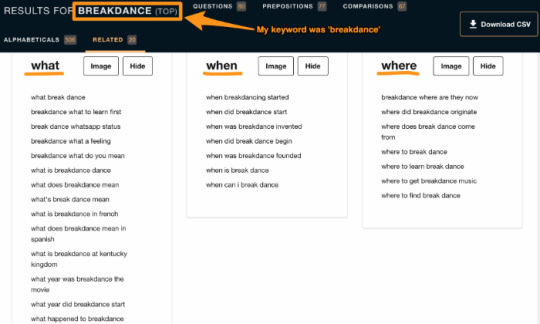
AnswerThePublic generates ideas for you based on different categories: questions, prepositions, comparisons, alphabeticals, etc.
There are plenty of other free tools out there, like:
Google Keyword Planner
Wordtracker Scout
Keywords Everywhere
Take your pick.
One of the most important metrics SEOs look at when doing keyword research is search volume. Essentially, search volume is the amount of searches per month for a keyword.
The problem with a free tool is that, while it’s free, it usually has either missing or incomplete data.
As such, you might want to consider using a professional keyword tool like Ahrefs’ Keywords Explorer (affiliate link).
You can access it using the Ahrefs’ $7 for 7-days trial.
Enter a seed keyword into Keywords Explorer, and it will generate thousands of keyword ideas, plus all sorts of relevant SEO metrics:

Here’s a quick explanation of everything you’re seeing in the above screenshot:
Keyword Difficulty (KD). Ahrefs’ Keyword Difficulty metric gives you an estimate of how hard it would be to rank in the Top 10 search results for a given keyword.
Search volume (volume). This shows you how many times per month, on average, people in a given country search for your target keyword.
Clicks. This shows you the average monthly number of clicks on the search results that people make while searching for the target keyword.
Cost-per-click (CPC). This shows you the average price that advertisers pay for a click on their ad in Google’s paid search results for a target keyword in a given country.
Clicks-per-search (CPS). This shows you the average number of clicks people perform after searching for a given keyword.
Return Rate (RR). This shows you how often the same person searches for a given keyword over a 30-day period.
SERP Features (SF). This refers to how many Google’s SERP Features appear in the search results for this keyword.
Parent Topic. This shows you a better topic you can target as opposed to the keyword you’re entered.
Lurk in Communities
There are communities for every imaginable topic out there.
Love the TV show Brooklyn Nine-Nine? There’s a subreddit for that. Enjoy discovering new products? Well, that’s how ProductHunt was formed.
You name it, they have it.
People gather in these communities to ask questions, discuss trending news, get recommendations, and so on.
Translation: these communities offer a wealth of topics for your niche site.
When we started, we hung out a lot on r/bboy, a subreddit for breakdancers. This was where we got our initial list of topics:

You can do the same too.
Do a search and find all the communities related to your niche. You can find them in places like:
Reddit;
Quora;
Facebook;
Slack;
Forums (yes, they still exist);
And much more.
To find out if these topics have search traffic potential, you can install the Chrome/Firefox extension Keywords Everywhere on your browser.

You can also enter these topics into Keywords Explorer.
Ahrefs will show you all the SEO metrics, plus suggest a better topic for you to target (“Parent Topic”).

Figure Out What Your Competitors are Ranking for
Your competitors have done the hard work for you. They’ve been blogging and ranking in Google.
Your job? Borrow generously.
Find out what’s working for them, and then replicate those topic ideas.
Most sites feature their best-performing posts on their blogs, usually in a sidebar:

You can easily see which keywords they’re optimizing for.
For example, the post 595 Power Words That’ll Instantly Make You a Better Writer is obviously optimizing for the keyword “power words.”
If you’re unsure, you can click through to the post. If they’re SEO-savvy, they would have optimized their URLs for the target keyword.

Of course, the best way is to use a tool like Site Explorer.
Enter your competitor’s domain into the tool and go to the “Top Pages” report, where you’ll see all the pages sending them the most search traffic:
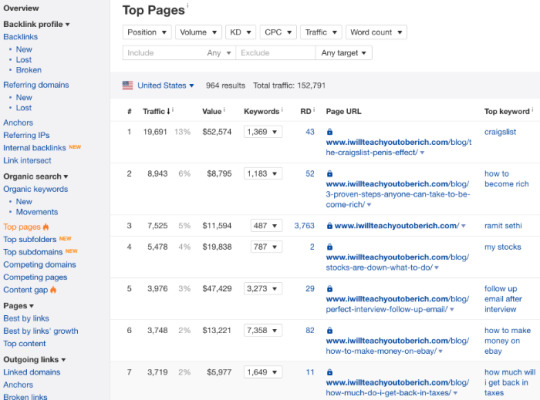
Key Takeaways
To get search traffic to your niche website, you need to target topics that people are searching for. To do this, you need to do keyword research.
You can either use a free keyword tool or a paid, professional version.
The paid version will also allow you to check all the keywords your competitor sites are ranking for.
To find out what your readers are searching for, you can also lurk in communities to find widely-discussed topics.
Further Reading
What to Blog About: 3 Steps to Mapping out Your Ideas in a Logical Way by Jon Morrow
Keyword Research: The Definitive Guide by Backlinko
How to Do Keyword Research for SEO by Ahrefs
Back to Top
4. Create Your Content
Jon Morrow is right:
“The best content is king.”
If you want to rank in Google, build an audience and compete with others, you have to create epic content.
You have to publish the best article ever written about those topics with search traffic potential.
The posts have to be detailed.
They have to be in-depth.
They have to answer every single question about that topic.
How I Created My Content
When we began our niche site, we were already huge fans of the detailed, long-form articles published by Smart Blogger and Backlinko.
So, we sought to emulate them.
We even published a 17,000-word article on how to get started with breakdancing.
It was our most successful article, but it took us almost a month to write.
You might be wondering:
“If you’re writing such long articles, how can you publish something every day?”
Answer: you don’t.
Publishing every day is a fool’s game.
What you should do is to focus on quality, not quantity.
If you have to publish less, so be it. Don’t sacrifice the depth of your article on some arbitrary content schedule.
(For us, it was impossible to stick to a schedule, as we had full-time jobs.)
You want to be known for the quality of your work — not how quickly you pump out new articles.
That being said, what does it mean to create great content?
When we started, all we knew was we needed to create something in-depth. We weren’t writers and had no blogging experience.
In short, we had no way to measure and define “great content.” We just went with our instincts.
Today, things are different. After reading and writing so many pieces of content, I can see which articles can be classified as great, and which can’t.
How I Would Create My Content Today
I no longer need to rely on my instincts. I know what “great content” is and what it must embody. It needs the following three characteristics:
Characteristic #1: Quality
Quality is subjective, of course.
How then do you know you’ve created something worth shouting about?
In my experience, quality consists of three factors:
Design. Is the website design great? Is it easy-to-read? Are the images beautiful? Or is the site cluttered with hundreds of banner ads, each distracting your reader from the main purpose, which is to consume the content?
Content. Does the article flow? Is it interesting, entertaining, and useful? Or is the article full of grammatical and spelling errors that makes reading it off-putting?
Usefulness. Does the article actually solve a problem? Does it discuss the topic in-depth? Or is it merely beating around the bush?
If the content you produce meets these three factors, it’s great content.
Characteristic #2: Uniqueness
There are thousands, if not millions, of articles published on similar topics each and every day.
Why would someone choose your article over the others?
The best way I’ve found to create unique content is to write from personal experience.
Pro Tip: This is how Smart Blogger became such a powerhouse in the blogging world. When Jon writes about blogging, it comes from his years of experience. When a guest author is invited to write about a topic, they’re chosen because they have had experience in those areas.
Characteristic #3: Authority
Do you want to learn astrophysics from a Caltech physicist, or your next-door neighbor?
Of course, it’s the Caltech physicist. (Unless, you once lived next to Richard Feynman.)
Your readers are the same way.
No matter the topic, they want to learn from an authoritative source.
If you’re the expert, great! Carry on.
But what if you aren’t?
Get the experts to help you. Be the journalist. The scribe. There are plenty of experts with great knowledge, but insufficient ability to communicate that knowledge.
You can be the go-between.
Interview them. Curate their thoughts, research and expertise. You can even invite the expert to write an article for you.
For example:
Tim Ferriss. Tim doesn’t have expertise in every topic in the world, but he touches lots of topics. He does this by inviting experts to contribute to his books.
Pro Tip: This is also the reason why Smart Blogger succeeded when many failed. If Jon doesn’t have experience in something (e.g. Kindle Publishing), he doesn’t write the article. Instead, he invites someone with experience to do it.
If you read our epic guide to breakdancing, you’d see it checked all three aspects we just covered:
Quality. While it wasn’t the best-designed post, we formatted it well and added a header image (done on Canva). We even added a Table of Contents!
Uniqueness. We wrote the entire thing based on our years of experience in dance. We told plenty of stories that were highly unique to what we had seen and observed.
Authority. All of us had at least 7-8 years of breakdance experience.
Key Takeaways
If you want to rank in Google, make sure you create great content.
Focus on quality — not quantity or satisfying some “content calendar.”
Great content has three characteristics: quality, authoritativeness, and uniqueness. You need to do all three.
Further Reading
How to Write a Blog Post in 2019: The Ultimate Guide by Liz Careathers
Demystifying Epic Content: How to Actually Create It (Not Just Jabber About How Important It Is) by Sonia Thompson
How to Write a Blog Post in 9 Steps (That People Actually Want to Read) by Ahrefs
Back to Top
5. Promote Your Content
Do you want to know the greatest lie in the content marketing world?
It’s this adage:
“If you build it, they will come.”
Nothing can be further from the truth.
Think about it.
According to the latest stats, there are 4 million blog posts published every single day. That’s a lot of noise.
That also means there is an extremely low chance that somebody will randomly stumble upon your site.
If you want traffic, you have to be proactive. You have to promote your content. You have to build links.
How I Promoted My Content
We focused on three promotion techniques:
Technique #1: The “Eager Sneezers” Technique
In a post published in 2015, Bryan Harris shared how he started an email list from scratch and got 205 subscribers in 48 hours.
The technique he used? “Eager Sneezers.”
Ignoring the fancy name, it’s essentially reaching out to your friends and inviting them to join your email list.
Bryan’s biggest takeaway was your friends want to help you (so let them).
We used a variation of this idea to get our early traction.
After publishing a post on breakdance music, we reached out to multiple friends to help share it.
Fortunately, as we were breakdancers ourselves, we had a number of breakdancer friends who were more than happy to help:
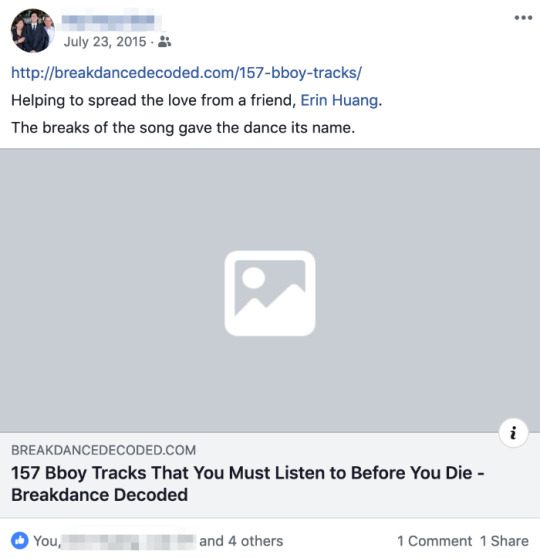
Technique #2: Community Content Promotion
Remember the communities you joined earlier (where you were “lurking” for ideas)?
They’re great for content promotion too.
Here’s one example of what we did:
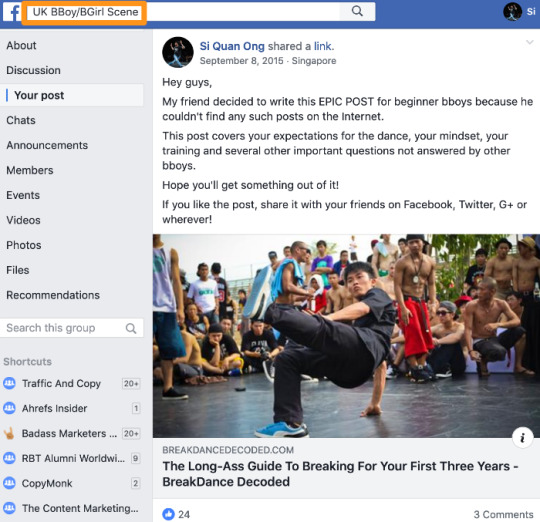
Now, this is not an excuse for you to strut into someone else’s community and start spamming links to your content.
Online communities exist for people to have meaningful conversations about a particular topic. Link spam defeats that purpose.
Plus, you’ll likely get booted out of the group.
The only reason I was able to promote my content in a group like this was because I was already an active member. I was participating in discussions, asking questions, and commenting.
I knew what kind of content the community would appreciate, which was why I was able to share it.
So, before you start dropping links to your content in a group, make sure you are active and understand the group’s rules.
Technique #3: Outreach to People You’ve Mentioned in Your Content
If you’ve written an epic piece of content, you’ve likely linked out to sources or quoted experts.
Let them know!
For example:
In our post, we listed 157 songs a breakdancer must listen to. This meant 157 different people we could email.
So, we did. And it resulted in one of the featured artists sharing our post on Facebook:

How I Would Promote My Content Today
According to a survey of 1,117 bloggers, higher-income bloggers put more emphasis on promoting their content than lower-income bloggers.
Translation: if you want to succeed, you have to keep on promoting your content.
If I were to create a new niche website, I would add these content promotion strategies into my toolkit.
Strategy #1: Outreach to People Who Published Articles on the Same Topic
Since they’ve written on that topic before, there is a higher probability they’ll be interested in seeing your post.
To find these people, simply enter the topic of your article (remember to try variations!) into Google. Collect the list of articles that appear in the SERPs.
Then find their email address and reach out.
Alternatively, you can use a tool like Ahrefs’ Content Explorer, a search engine for web content.
Enter the topic into Content Explorer, do some filtering (like “English only”), and export the list.
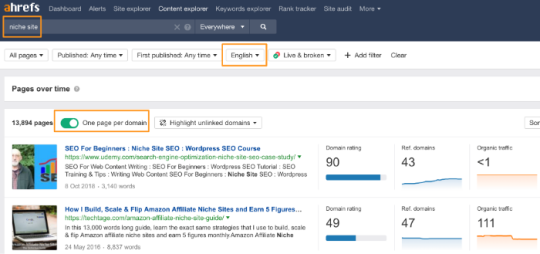
You now have a huge list of sites to reach out to.
All that’s left is to write the email.
Here are a few tips to help you write a compelling email:
Keep it short. Most people are busy. You improve your chances of getting your emails read if it’s short and to the point.
Tell them what’s in it for them. Everyone looks out for #1. Provide value upfront and let them know what they can get out of it.
Personalize the email as much as possible. People can tell when an email is a template. If they think it’s a template, they’ll delete it without reading.
Ask wisely. People dislike being told to do something. Don’t be pushy. If you’re asking for a link, suggest the idea gently.
You can also read this in-depth guide about blogger outreach.
Strategy #2: Guest Blogging
Guest blogging is a tactic where you write a post for another website (instead of yours).
In exchange for your “free” article, the owner gives you:
A few links back to your site (either within the body content or inside the author’s bio);
Exposure to their audience;
Referral traffic.
Those are just the immediate benefits. Guest blogging also allows you to build relationships with influencers, or even grow your email list.
The biggest challenge with guest blogging is finding blogs willing to accept your guest posts.
To increase your chances of being accepted, look for sites that are already accepting guest posts.
You can find these sites via Google search operators. Here are a few examples:
[your_topic] “write for us”
[your_topic] “become an author”
[your_topic] “guest post”
[your_topic] “guest article”
[your_topic] inurl:contribute
These sites usually have a “write for us” page, so all you have to do is to follow their instructions.
You can also look for these opportunities in Content Explorer. The reasoning: if a blog has written about a topic before, there is an increased probability they would cover it again.
Enter any word/phrase from your niche into Content Explorer.
Check the “one article per domain” box to get a list of unique domains you can potentially write for:

Some of these sites may not have an obvious “write for us” page. But, most blogs will accept a guest post if your pitch is good enough.
Key Takeaways
If you want traffic, you have to promote your content.
To kick-start your site and get some initial traction, try the “Eager Sneezers” technique.
You can also promote your content in communities.
If you’ve mentioned anyone in your posts, reach out and let them know.
To take it to the next level, try guest blogging and reaching out to people who’ve written about similar topics.
Back to Top
6. Grow Your Email List
Study the best sites in any niche, and you’ll notice one thing:
They all build an email list.
An email list is powerful because you can do almost anything with it. You could:
Survey your subscribers to get content ideas;
Ask them for feedback;
Test monetization ideas;
Sell something.
The possibilities are virtually endless.
How I Built My Email List
Because we were observing these huge sites, we understood the power of the email list very early on. In fact, we obsessed over collecting as many emails as possible.
We tested all kinds of strategies on the site.
Welcome Mats:
Content Upgrades:

We even turned our homepage into an email collection machine:
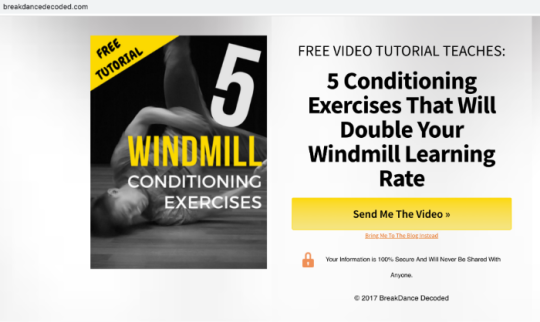
How I Would Build My Email List Today
In hindsight, we were too aggressive with our email collection.
We were so concerned with the number of emails on our list, the quality of our list suffered.
We should have focused on user experience and only placed email sign-up forms where relevant.
Over the years, Jon and the rest of the Smart Blogger team have written tons of guides on email list building, so I won’t delve too deeply into this topic.
You can check out the different resources here:
The Ultimate List-Builder’s Resource Guide: 109 Links to Double or Even Triple Your Subscribers
9 Irresistible Incentives That’ll Grow Your Email List Like Crazy
10 Creative Places for Opt-In Forms That’ll Supercharge Your Signups
9 Plugins for Growing Your Email List That Work So Well It Feels Like Cheating
The Quick and Dirty Guide to Creating Your “Bribe to Subscribe” in Record Time
Key Takeaways
Build a list! It’s the most important thing you need to do.
Test different methods for collecting emails on your site.
But don’t neglect user experience. Don’t cram 100 pop-ups on your site just so you can get a few more subscribers.
Back to Top
7. Experiment with Monetization
What’s the purpose of a niche site?
To make money!
As you start gaining traction on your site, and gaining a few subscribers, you can start to look into monetization.
How I Monetized My Site
At BreakDance Decoded, we experimented with a few different strategies.
Strategy #1: Patreon
Patreon is a membership platform where fans can “fund” content creators. You can create separate tiers on Patreon to reward different levels of loyalty.
Back then, Patreon was a relatively new-ish platform. We saw that a few legitimate artists and creators were generating significant amounts of money on the platform, so we gave it a shot.
This was our Patreon page:

No matter how hard we marketed ourselves, the best we did was $50 per month on Patreon.
That’s not to say Patreon doesn’t work.
There are plenty of successful Patreon artists, like Kurzgesagt, who has over 12,000 patrons supporting his work:

Your results may vary.
Strategy #2: YouTube AdSense
In addition to our website, we were also running a YouTube channel. So, we decided to see if we could make enough money from YouTube.
Yes, we dreamed of being the next PewDiePie.
These were our results:

It was decent, but it wasn’t enough for a “passive income” source.
Plus, our niche was too “specific”, so we probably didn’t generate enough views to make financial sense.
Strategy #3: Coaching
One of Jon’s recommendations was to sell video or phone coaching as a quick way to monetize your site.
We took it seriously.
We sent an email to our list, telling them we were available for personal breakdance coaching. At the time, this was a relatively new concept to the niche, so we weren’t sure if it would work out.
Surprisingly, someone took us up on it.
Strategy #4: Online Courses
By 2025, the e-learning industry will grow to about $325 billion in size.
This probably explains why most popular blogs monetize via online courses.
However, our biggest concern (back then) with an online course was the time and effort it took to create a great one. Plus, we weren’t sure if there were any demand for an online breakdance course.
The notion of spending considerable time, effort, and money into creating a course no one wanted didn’t sound appealing.
But after testing all the different strategies listed earlier, creating an online course seemed to be the most viable option.
So, we decided to launch a MVP (Minimum Viable Product).
We sent a survey to our email list, asking them for their #1 challenge.
From there, we came up with a hook we thought would interest our audience:
Hey friend,
Don’t you feel like breaking has limited support and not enough is done to help you improve?
Sure, there are tons of studios out there, and jams have become widespread.
But not every breaking tutorial fixes the problem effectively. Not everyone gets access to the information and knowledge from other bboys. Not every country or state has a strong breaking scene.
This lack of environment for growth sucks, because so many potential bboys and bgirls around the world deserve a chance to learn breaking.
Ideally, a bboy/bgirl’s progress should only be ‘limited’ by their own effort. Not the environment.
As a first step to tackle this problem, I’ve created a 1-minute survey to get to know you better (don’t worry it’s 5 simple questions, no right or wrong answers here.)
So click this link to fill up our quick survey!
Thanks for helping me to understand your breaking views. It will go a long way for both you and me 🙂
While we waited for feedback, we created an outline for a potential 9-week course.
Using the email hook and the outline, we crafted a 5-day email sequence modeled after Ramit Sethi’s successful launches.
Not knowing what to charge, we decided on an arbitrary sales price of $37. For the test to be successful, we told ourselves that we needed at least 10 sales.
As we weren’t technically savvy, we had no idea how to collect orders online. We also didn’t have money to invest in a shopping cart software.
So, we kept it simple:
We created a PayPal link.
Then we activated the 5-day campaign by sending our subscribers a launch email.
To our surprise, we actually managed to sign up 12 students.
Our test was successful!
The only issue? We now had to actually create the course.
Once again, instead of investing in some complicated course software to launch it, we decided to do it the easy way:
Facebook had just launched its “Live” feature and was heavily promoting it.
We decided to use it.
We created a closed Facebook group, sent an email to our 12 students, and invited them to join the group:
Our Closed Facebook Group
Then we filmed each lesson by using Facebook’s Live feature.
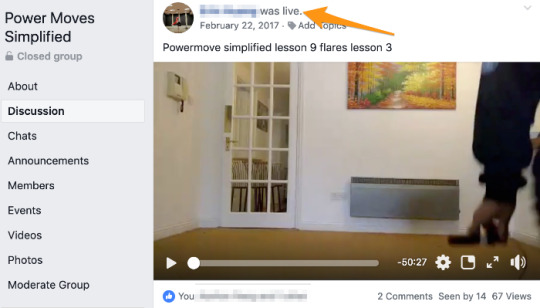
Besides some technical issues (like audio), we received rave reviews for our course.
Takeaway:
Don’t let perfectionism stop you from launching. People buy courses for the information, not the software you use or how perfect it looks.
What I Would Do Differently Today
I wouldn’t change a thing.
Online courses worked for me then, and it’s the monetization strategy I would use today.
That said…
Your results may vary.
It’s a good idea to play around with different monetization methods to see what works best for you. Even if you find a cash cow, always be looking at different ways you can diversify your income stream.
Otherwise, you’re asking for trouble.
Nomadic Matt has a blog that receives 1 million visitors each month, but as shared in his interview on Noah Kagan Presents, if he had continued with the same business model he had when he started (i.e. selling links), his business would have been dead in the water by now.
Key Takeaways
Test different monetization strategies and see which one works out best for you.
Patreon, online coaching, and online courses are all viable methods to generate revenue.
You can also consider other methods like affiliate marketing, selling eBooks, and so on.
Further Reading
How to Make Money Blogging (Free Guide for 2019) by Jon Morrow
Affiliate Marketing for Beginners: Go from 0 to $1,000 In Passive Income by Leanne Regalla
How to Make Money Writing: 5 Ways to Get Paid to Write in 2019 by Glen Long
Back to Top
Are You Ready to Create a Profitable Niche Website?
This wasn’t a case study about how successful I am or how many Lamborghinis I now own.
It’s the opposite.
My site wasn’t successful by any means.
Instead of sipping mojitos at the beach, I’m still working out of an office.
But that’s because I didn’t know then what I know now.
Now I know better. Now I know what to do. And now so do you.
It is possible to build a niche website and monetize it.
So what are you waiting for?
Paradise is waiting.
About the Author: Si Quan Ong works in marketing and customer success for Ahrefs, the SEO toolset that helps you grow your search traffic, research your competitors and dominate your niche. If not evident by now, he also breakdances on the side, and has a dream to visit 100 countries. Follow him on Twitter to learn more about his misadventures.
The post How to Build a Niche Website (Step-by-Step Case Study) appeared first on Smart Blogger.
from SEO and SM Tips https://smartblogger.com/niche-website/
0 notes